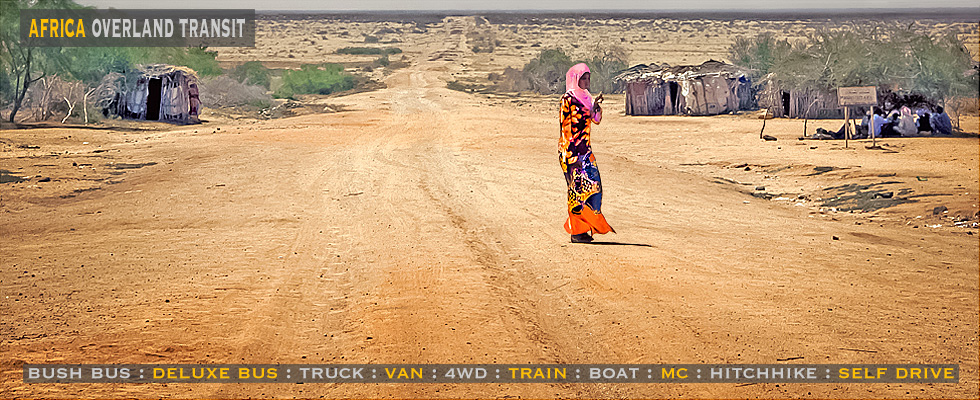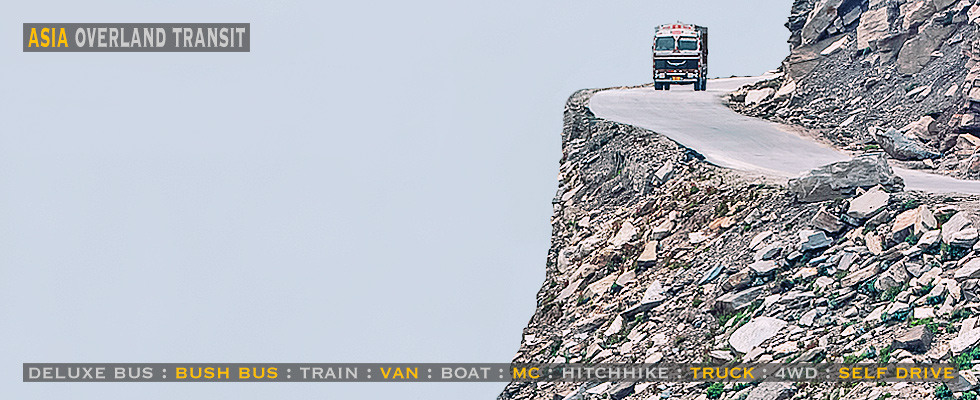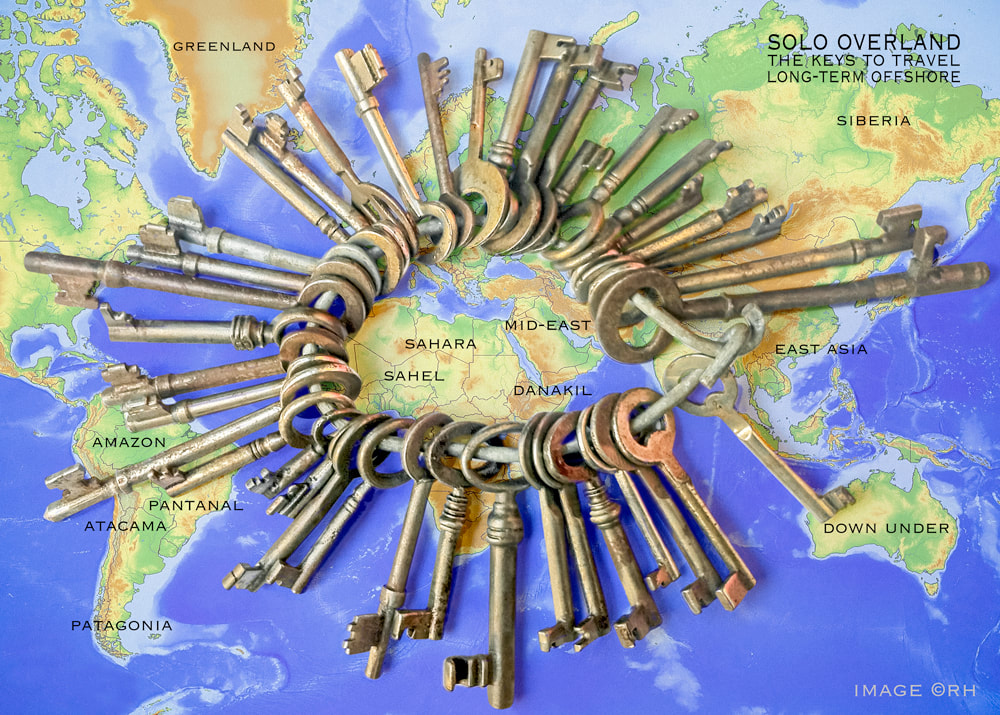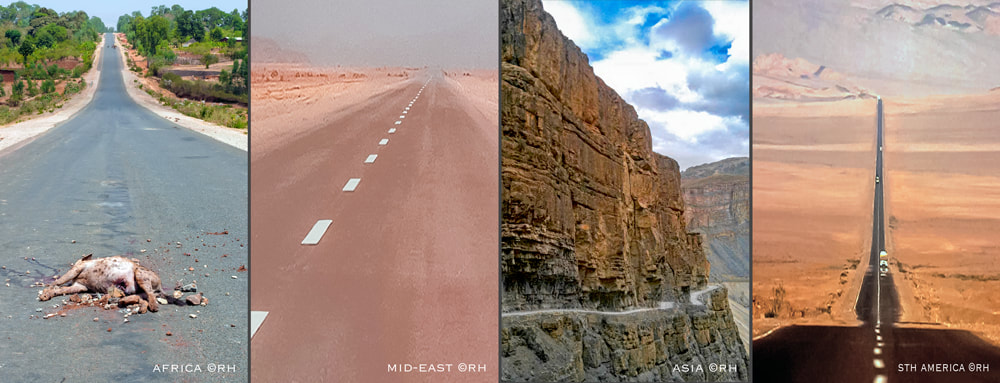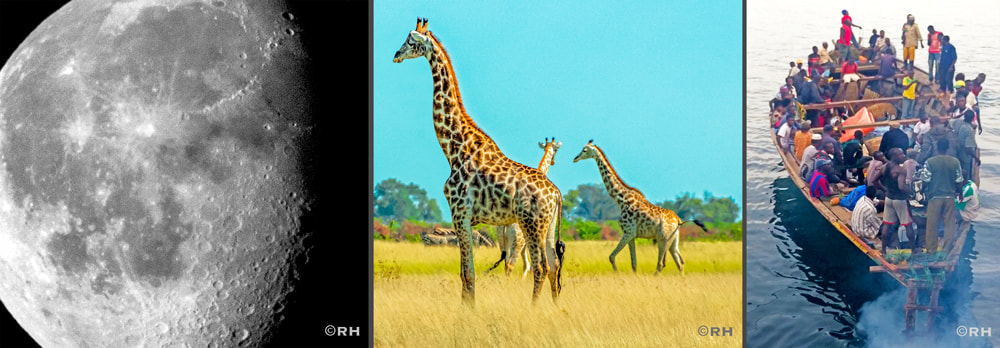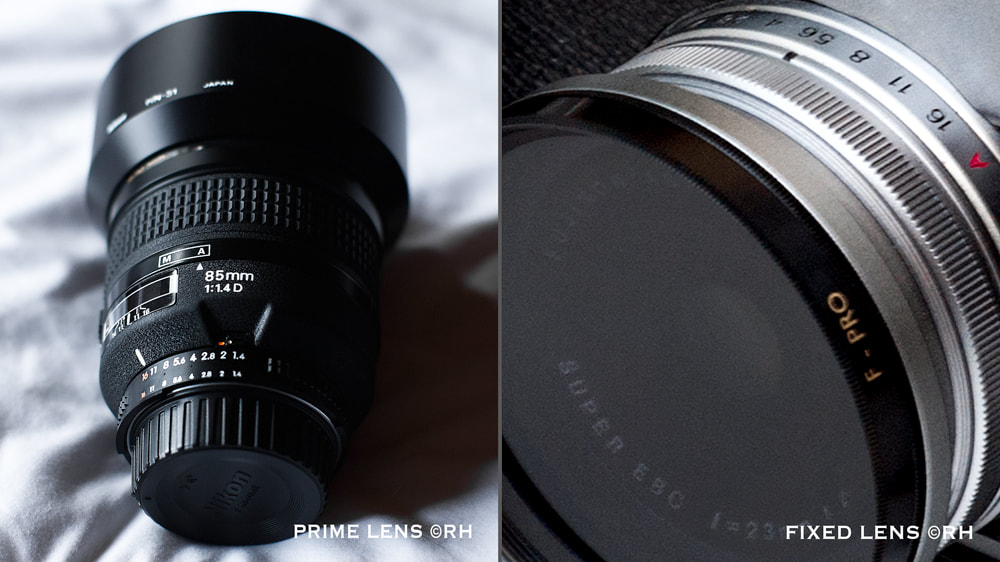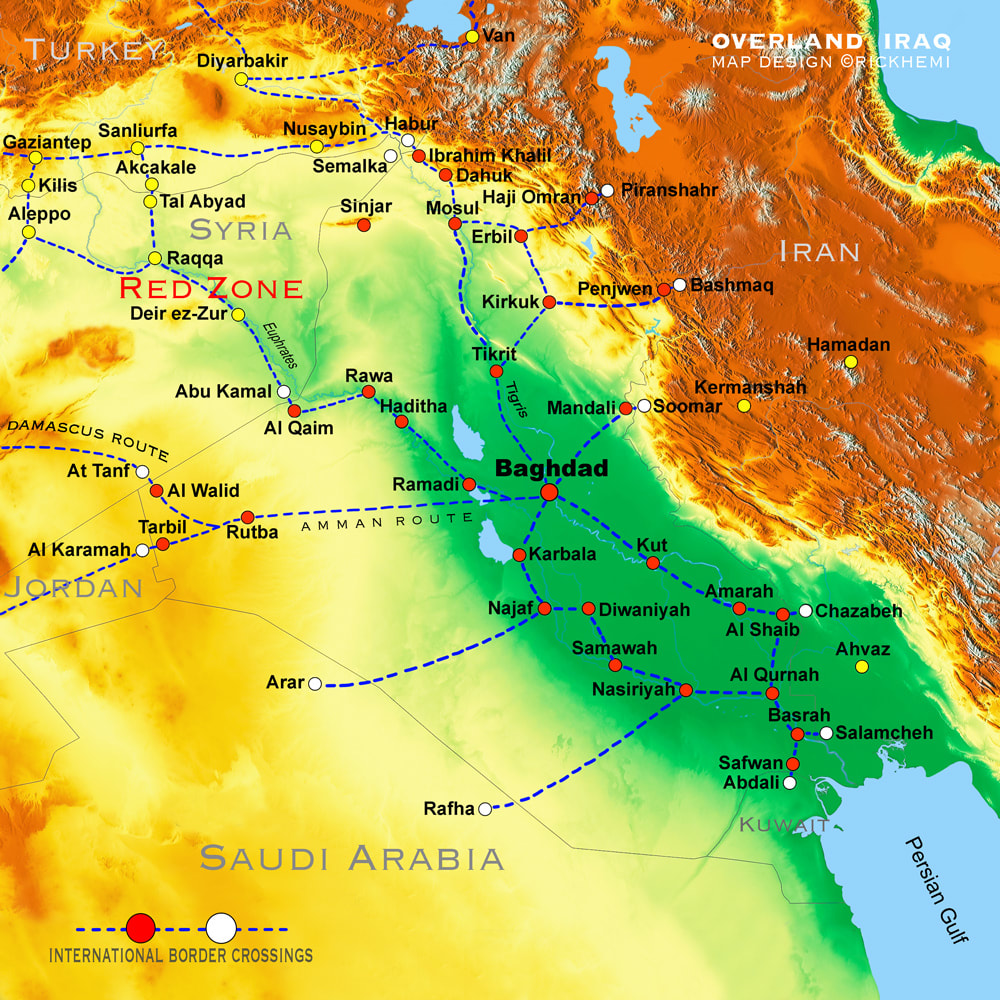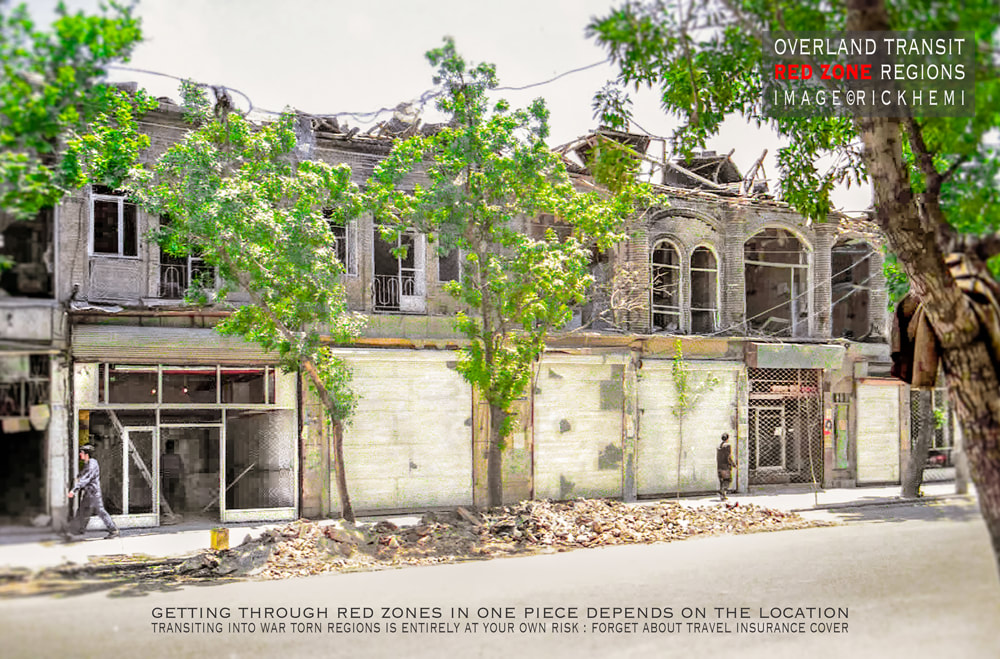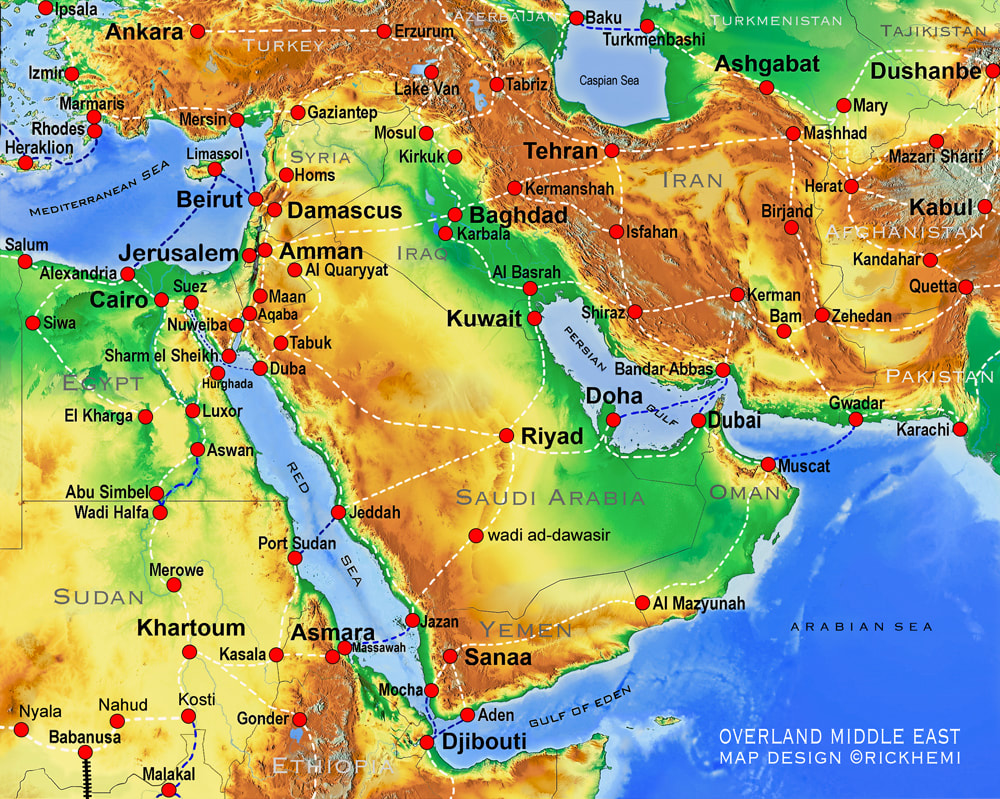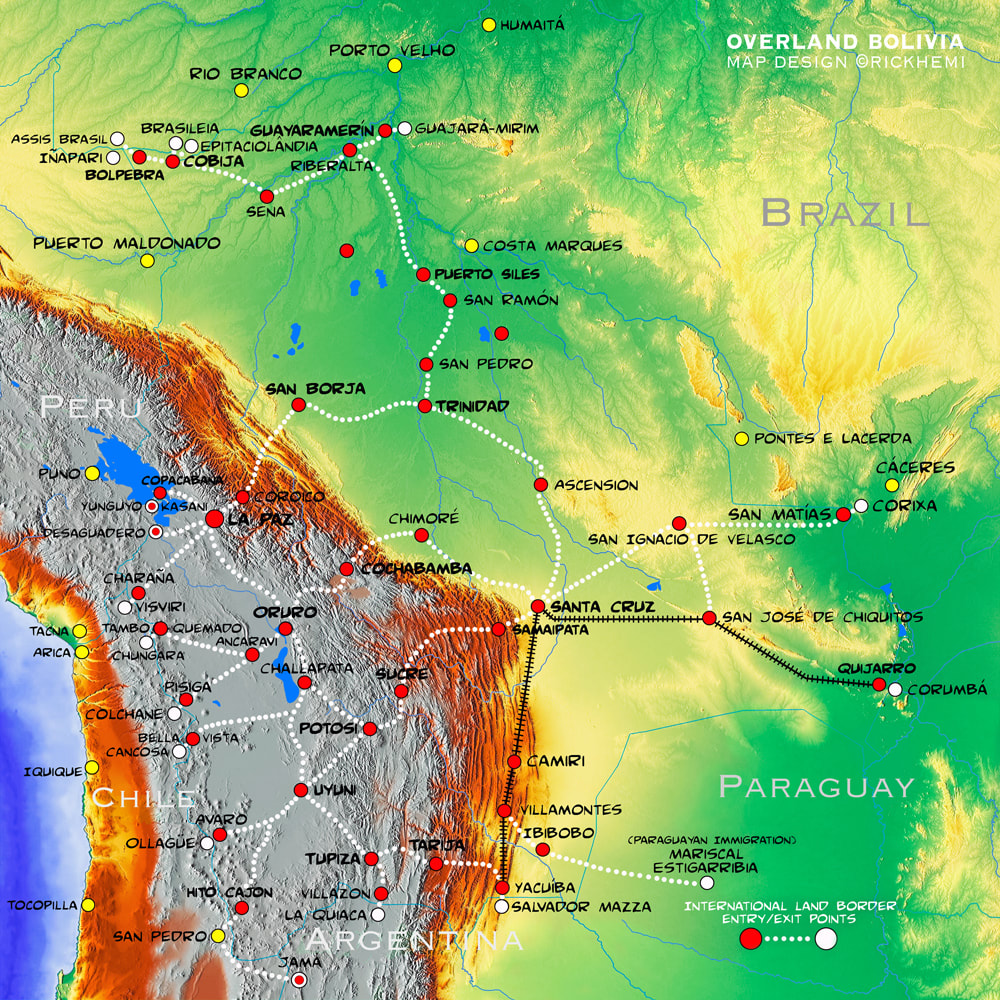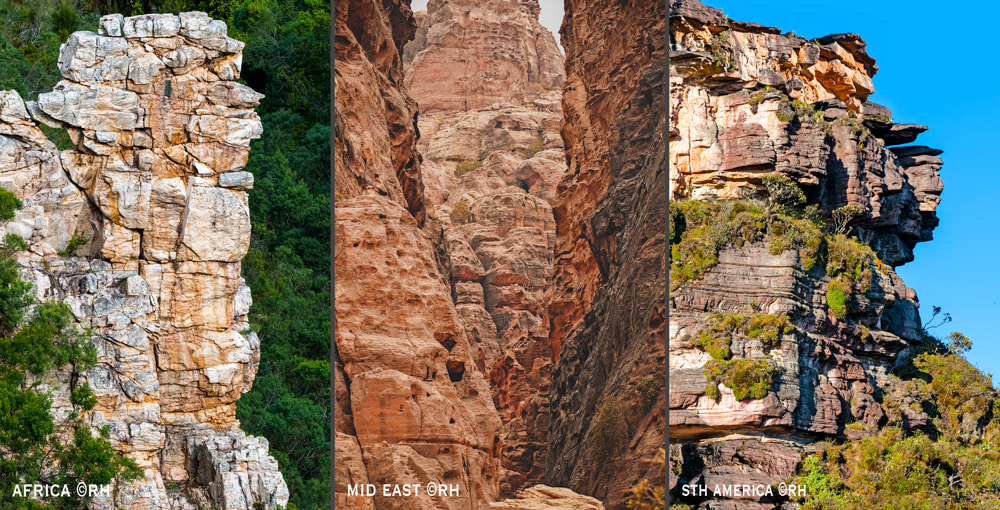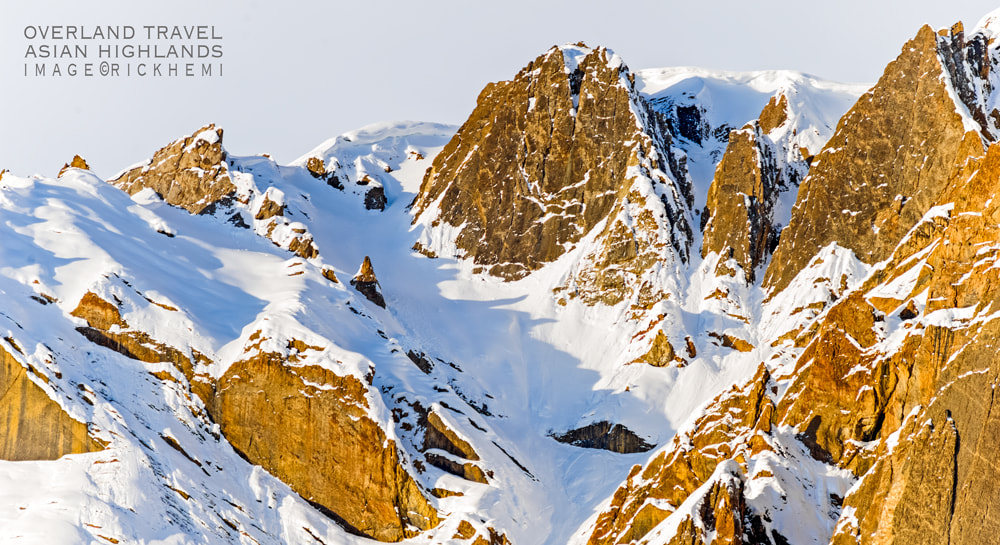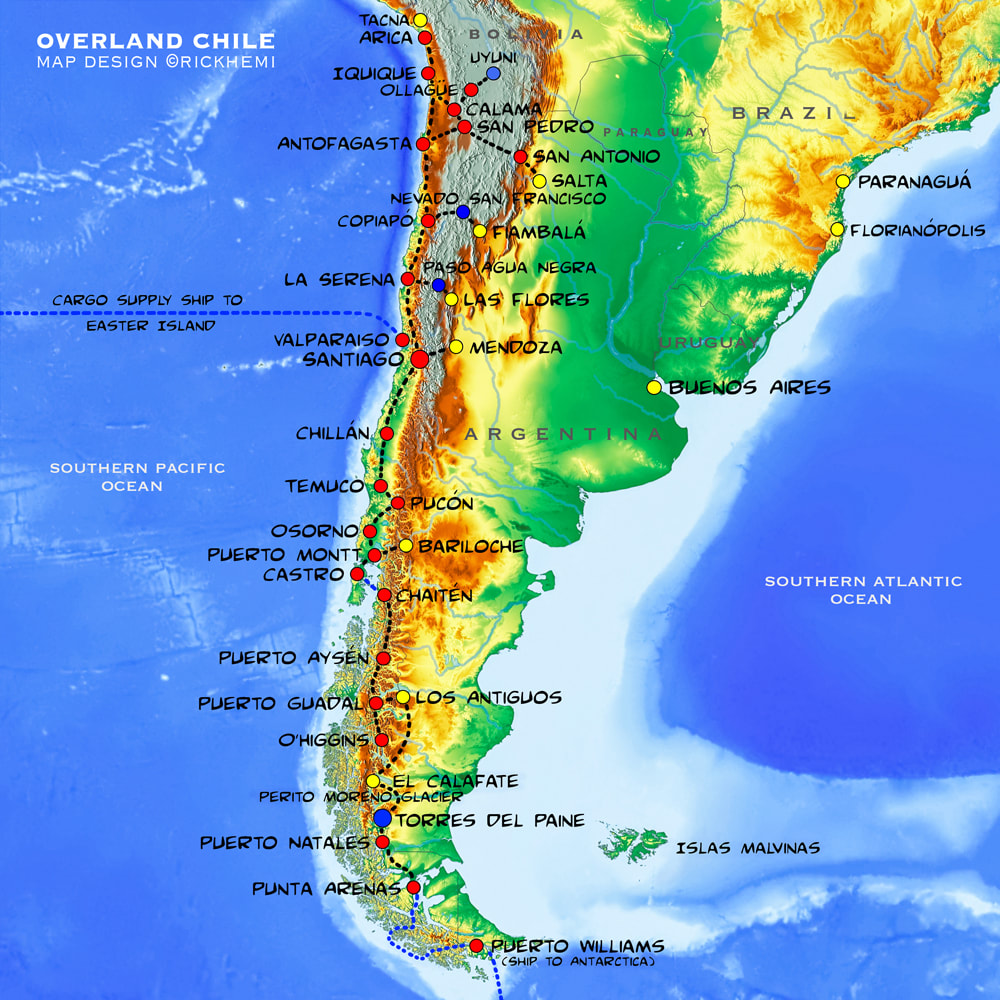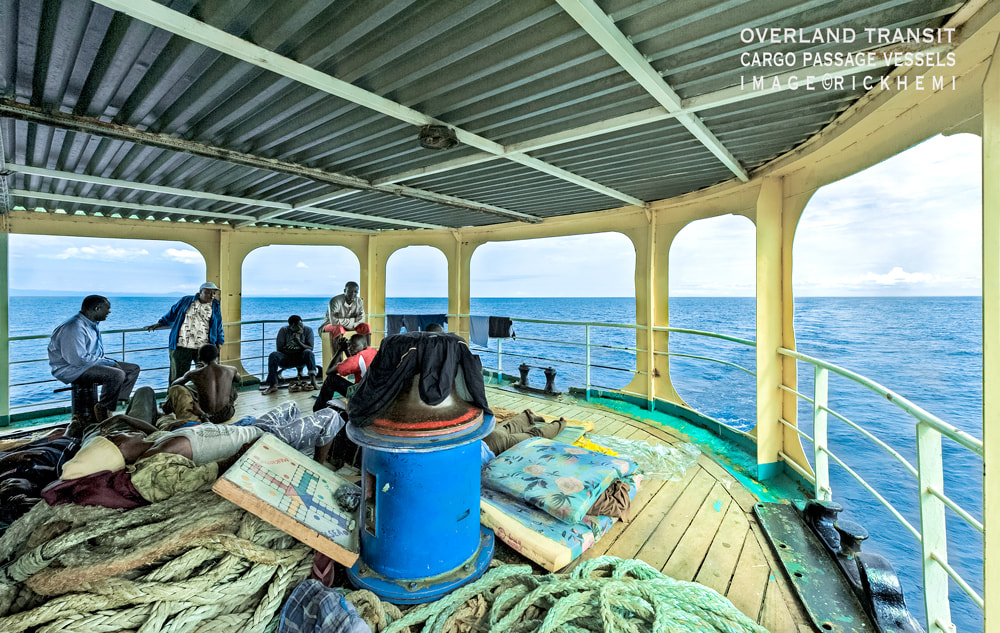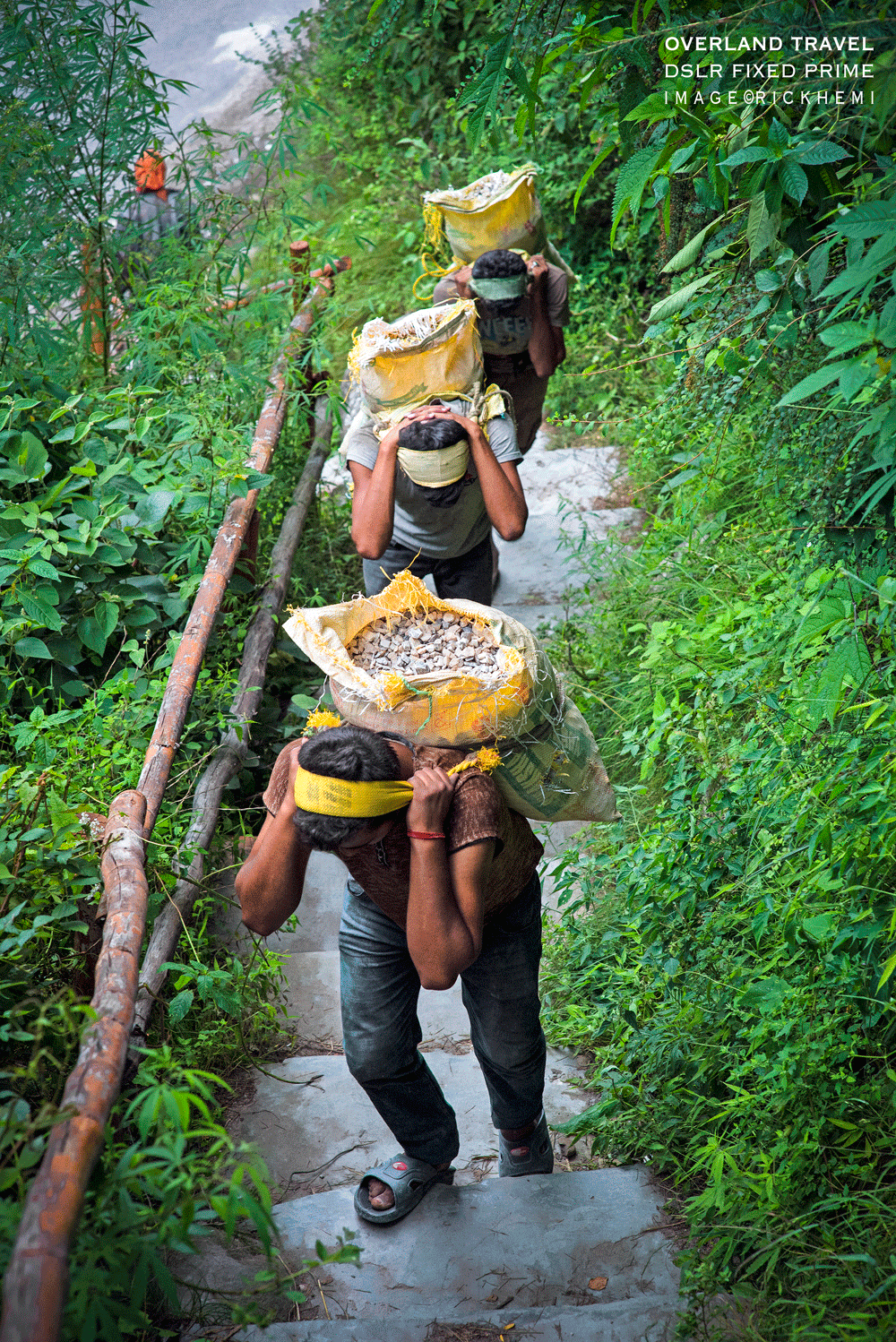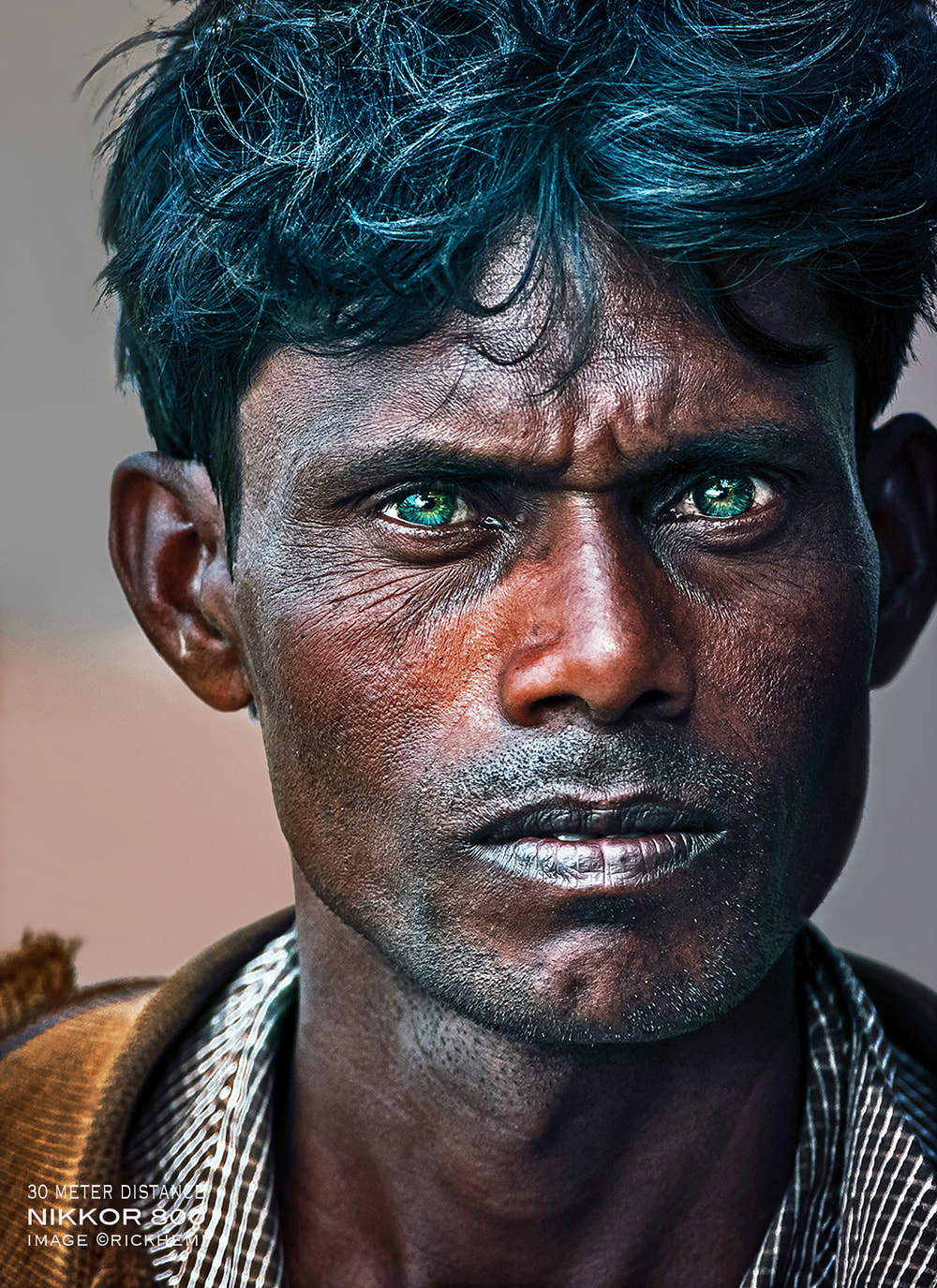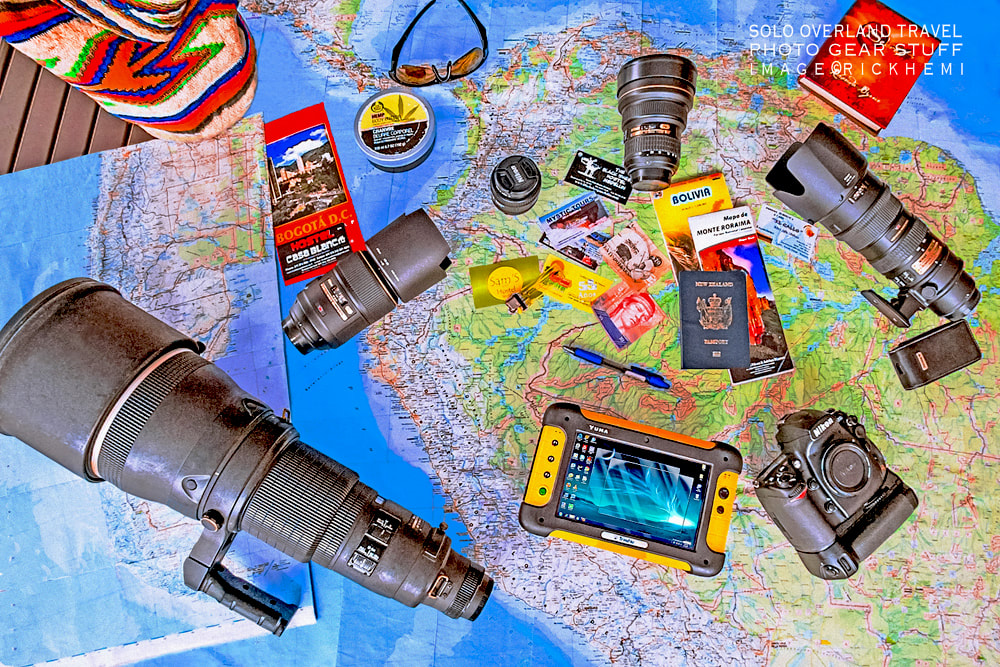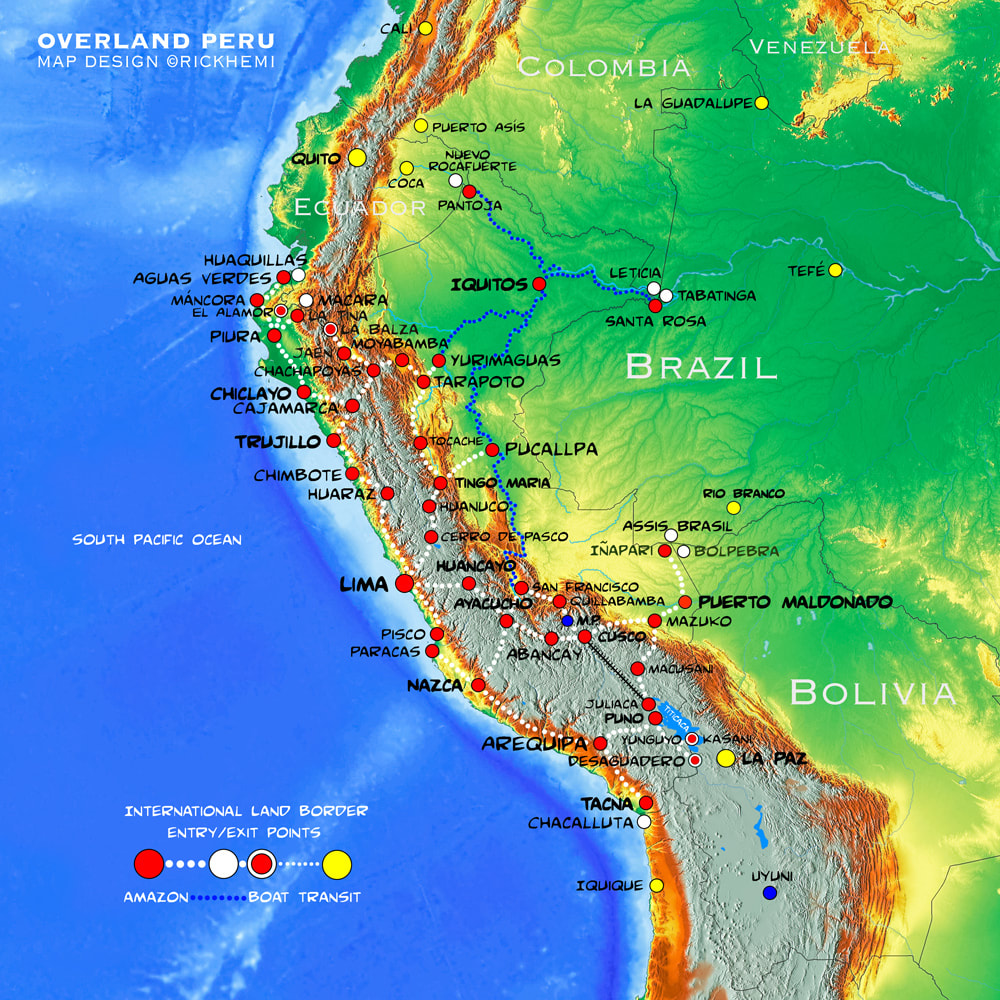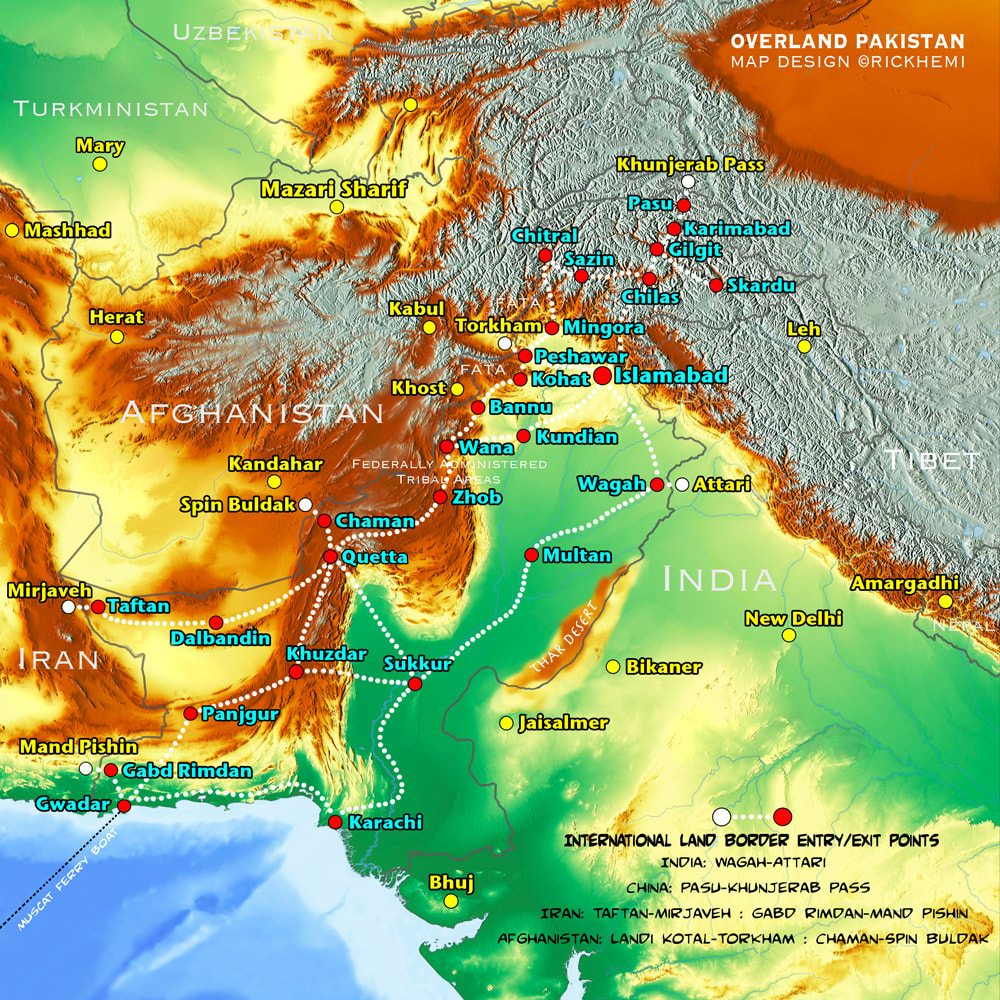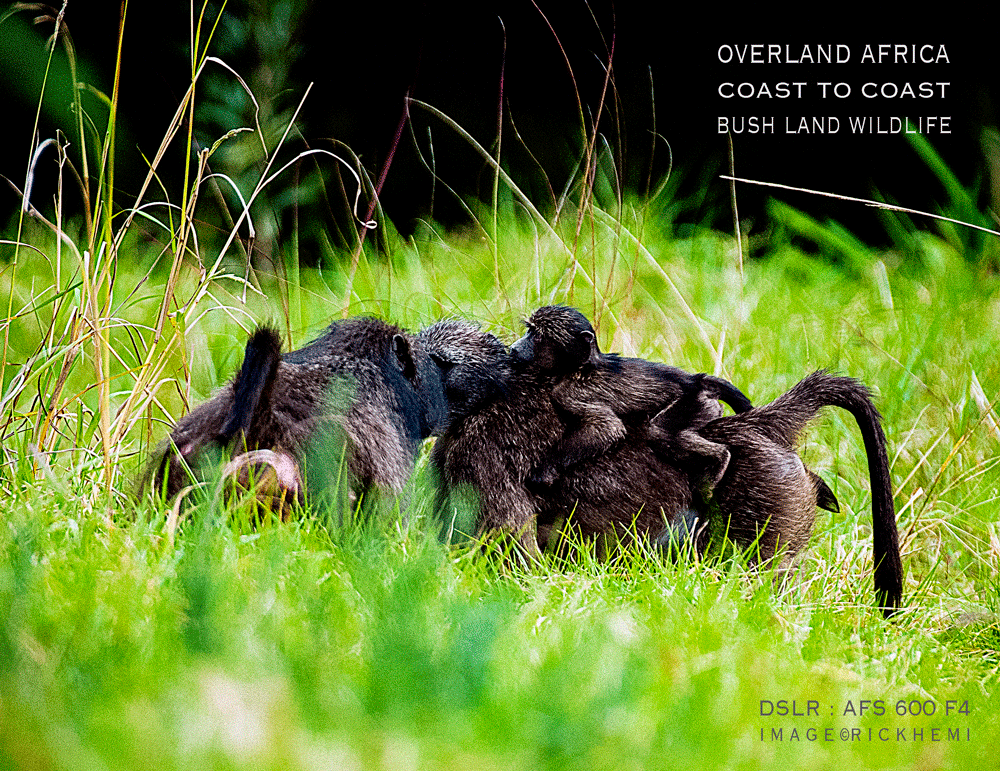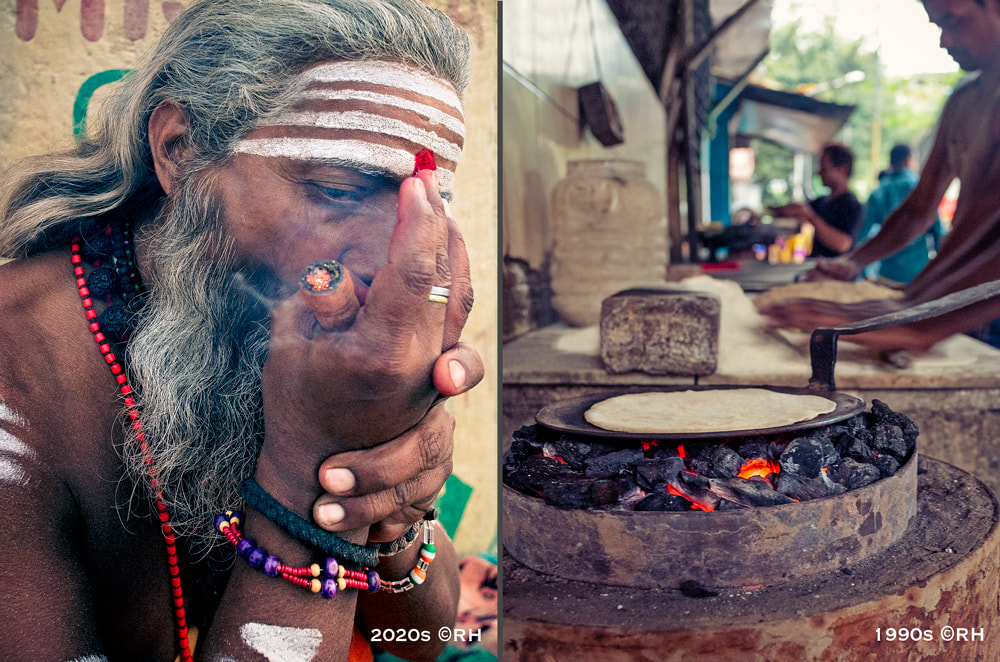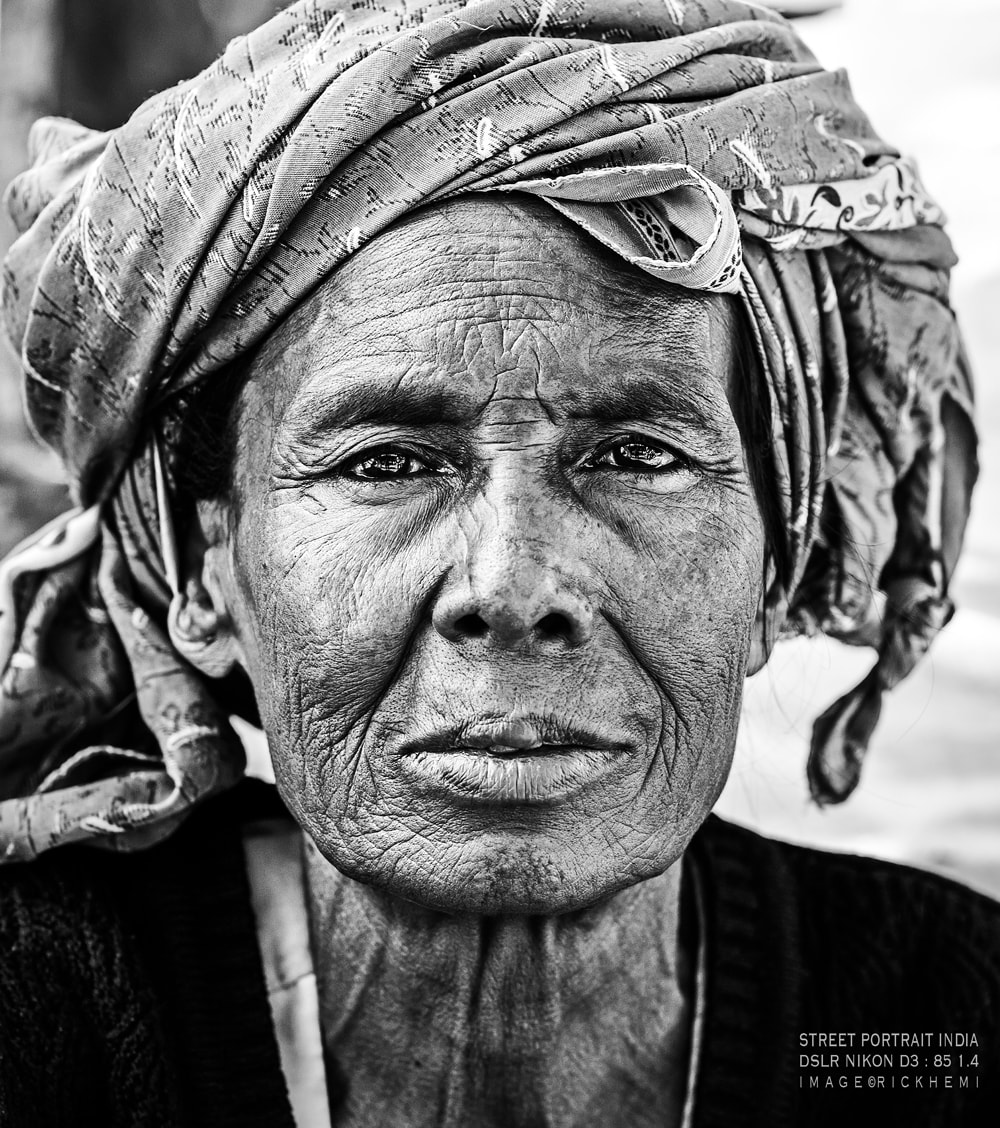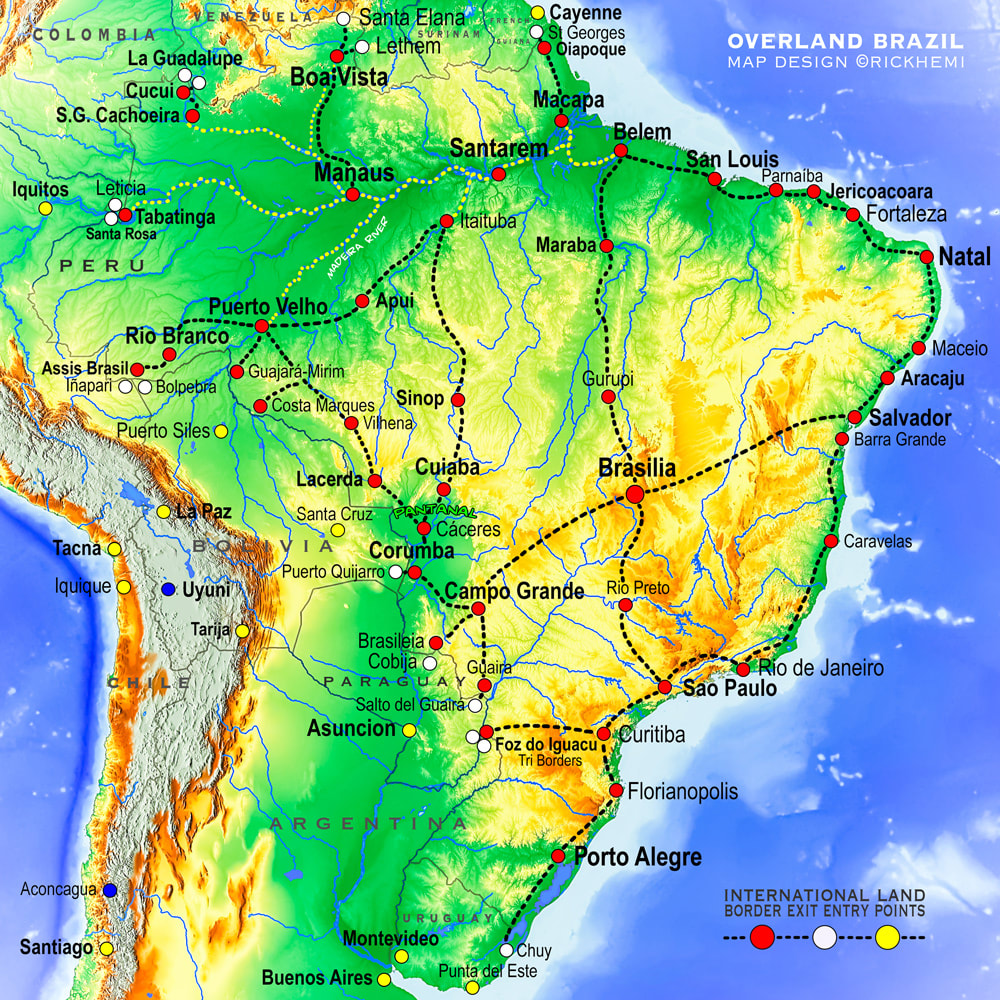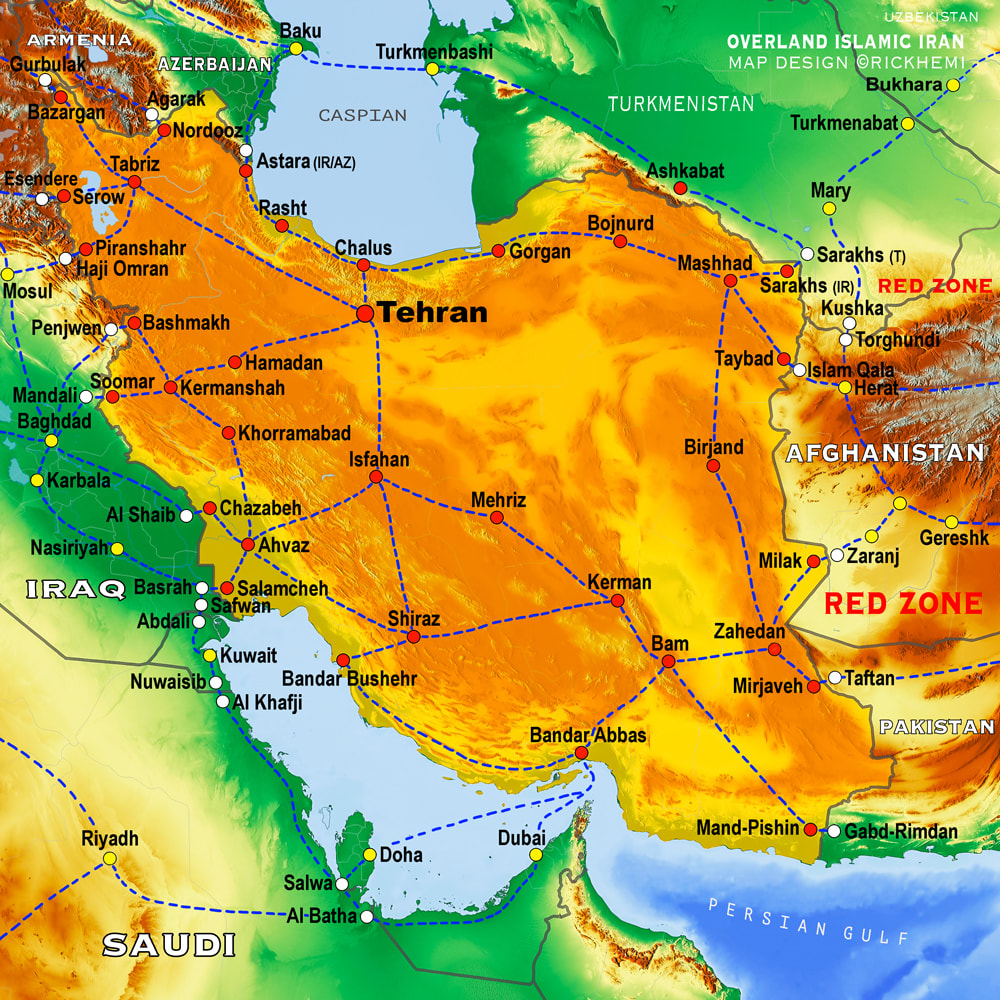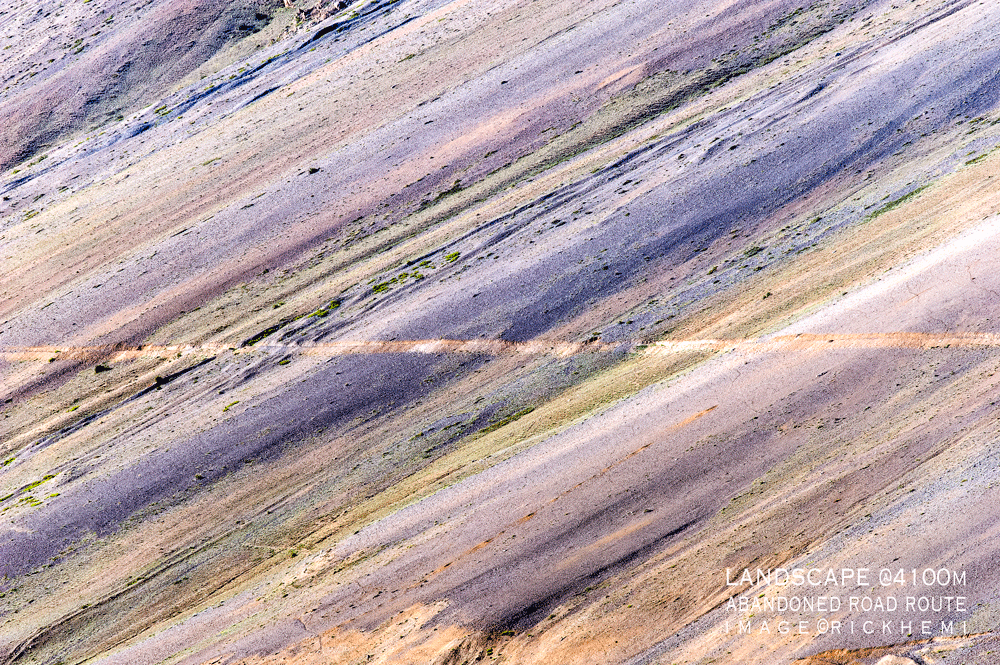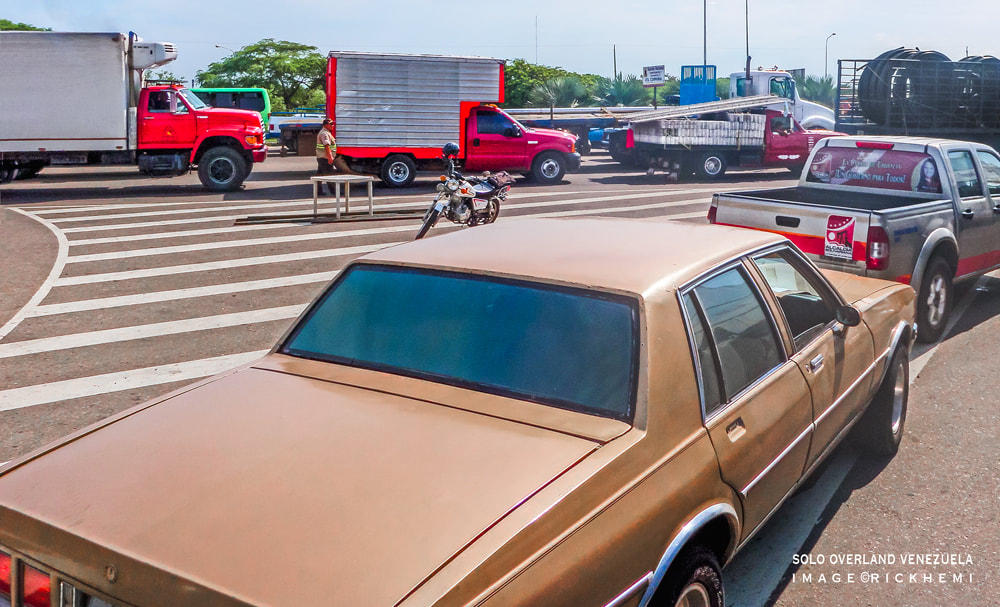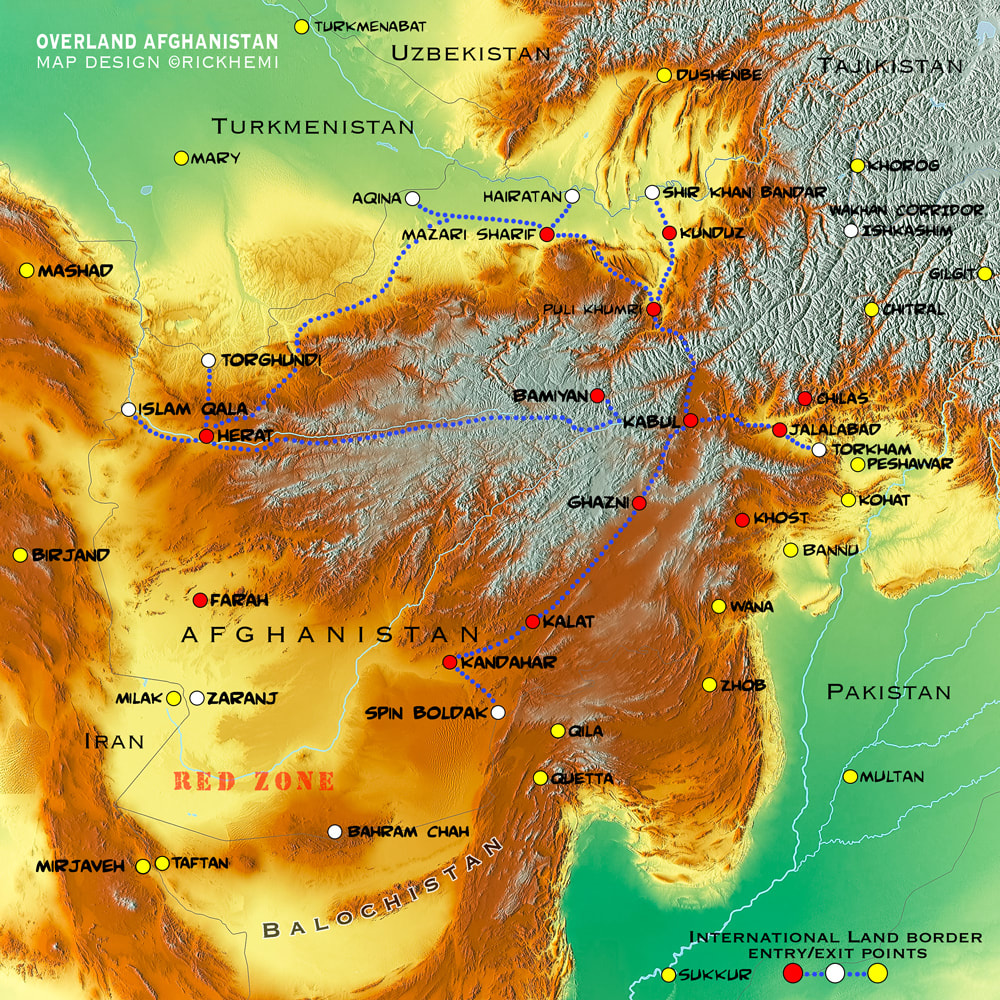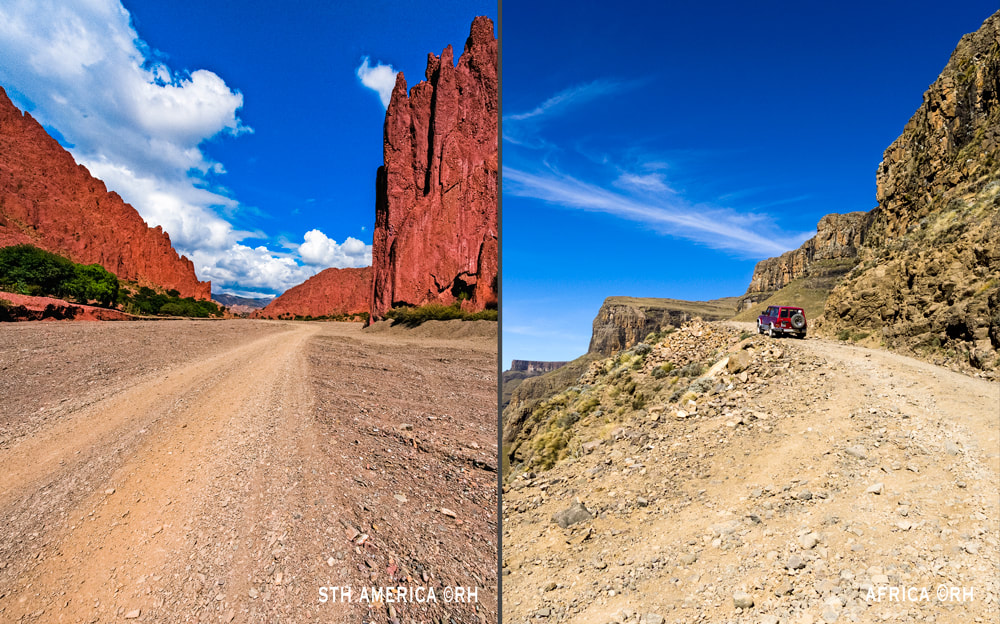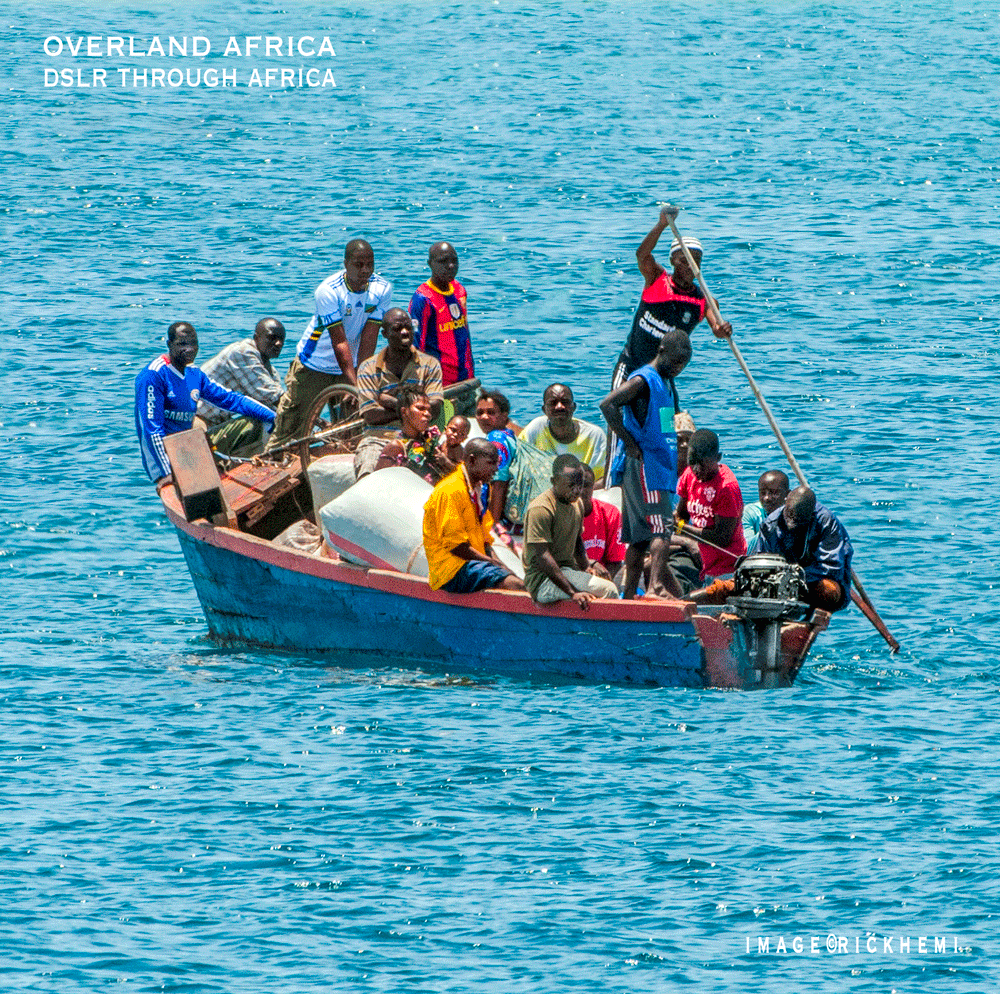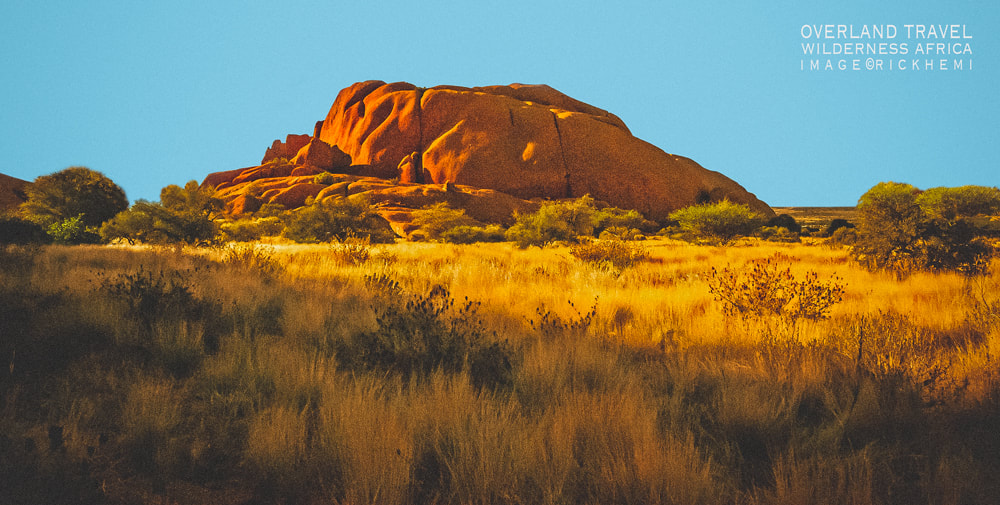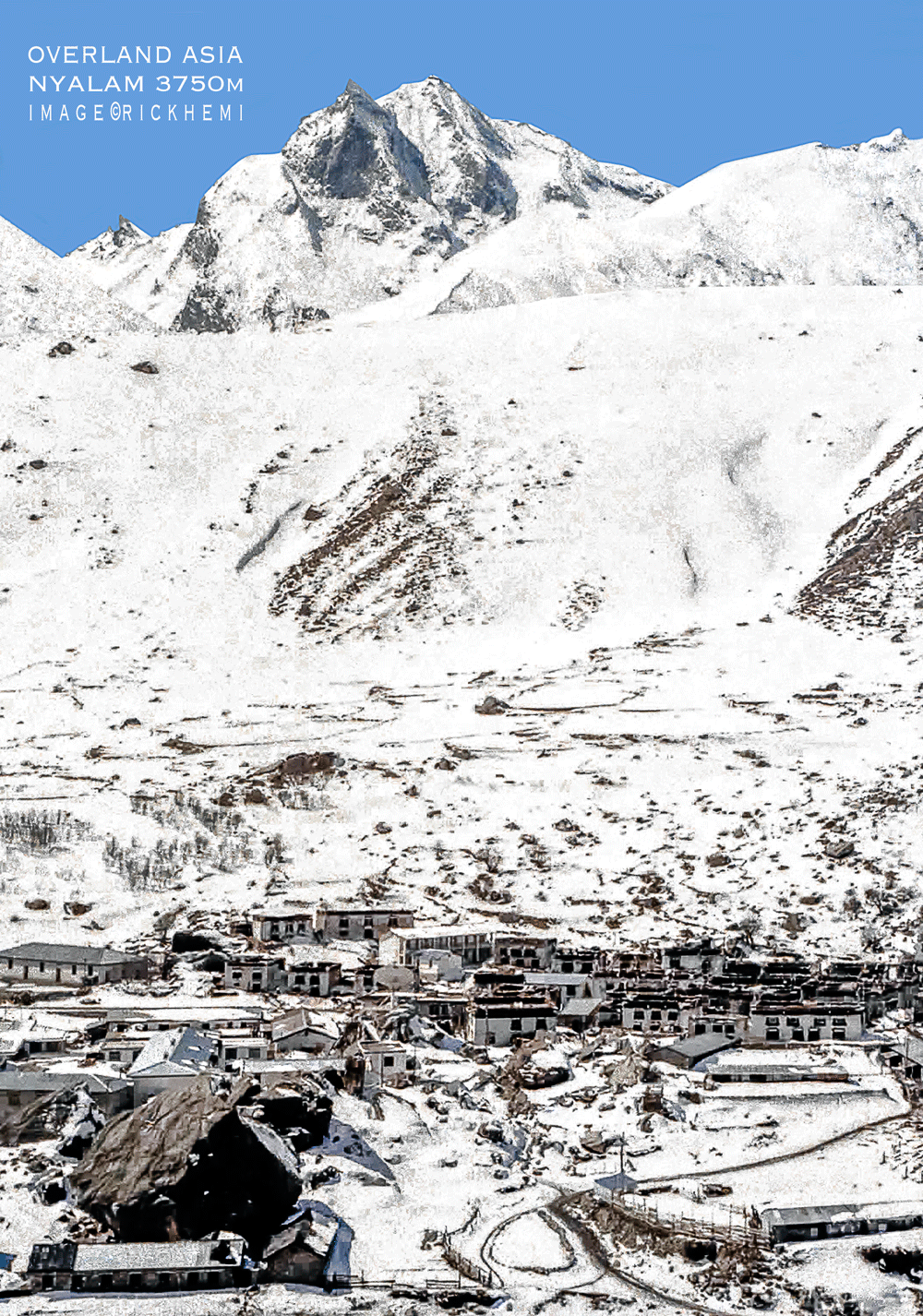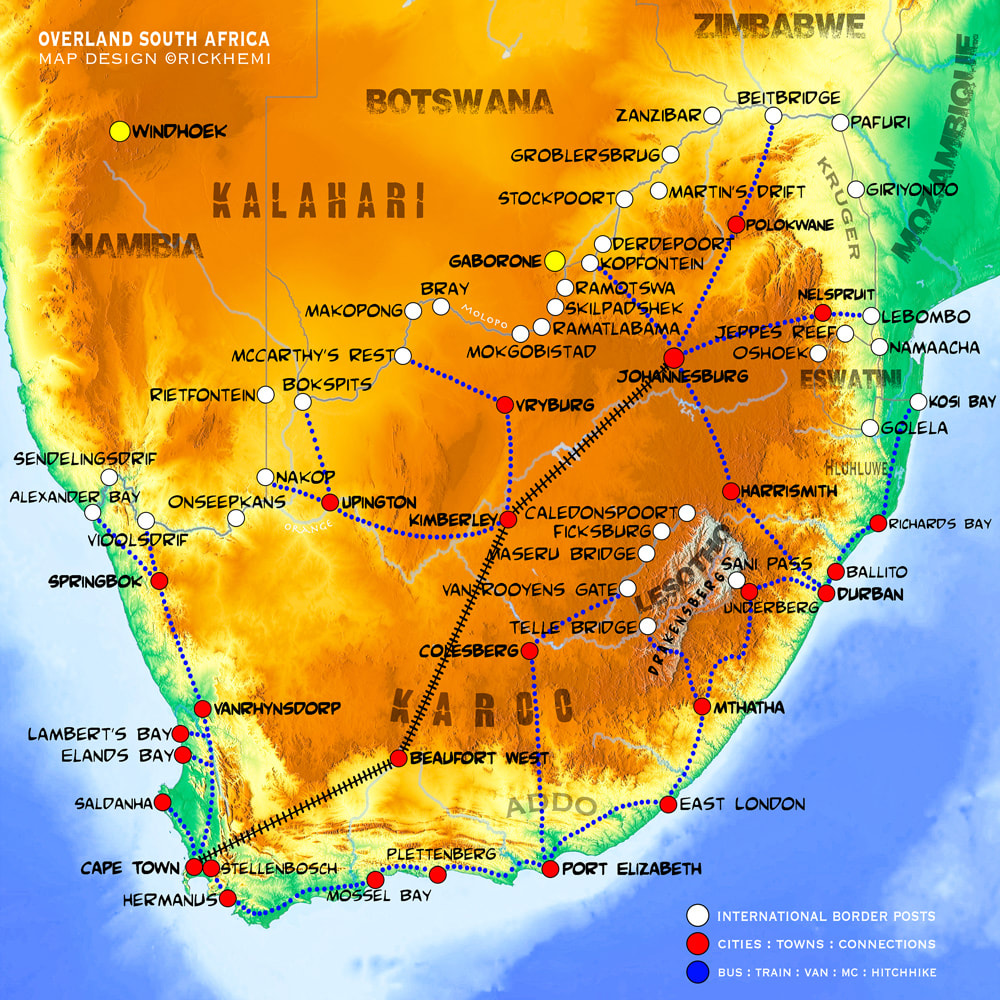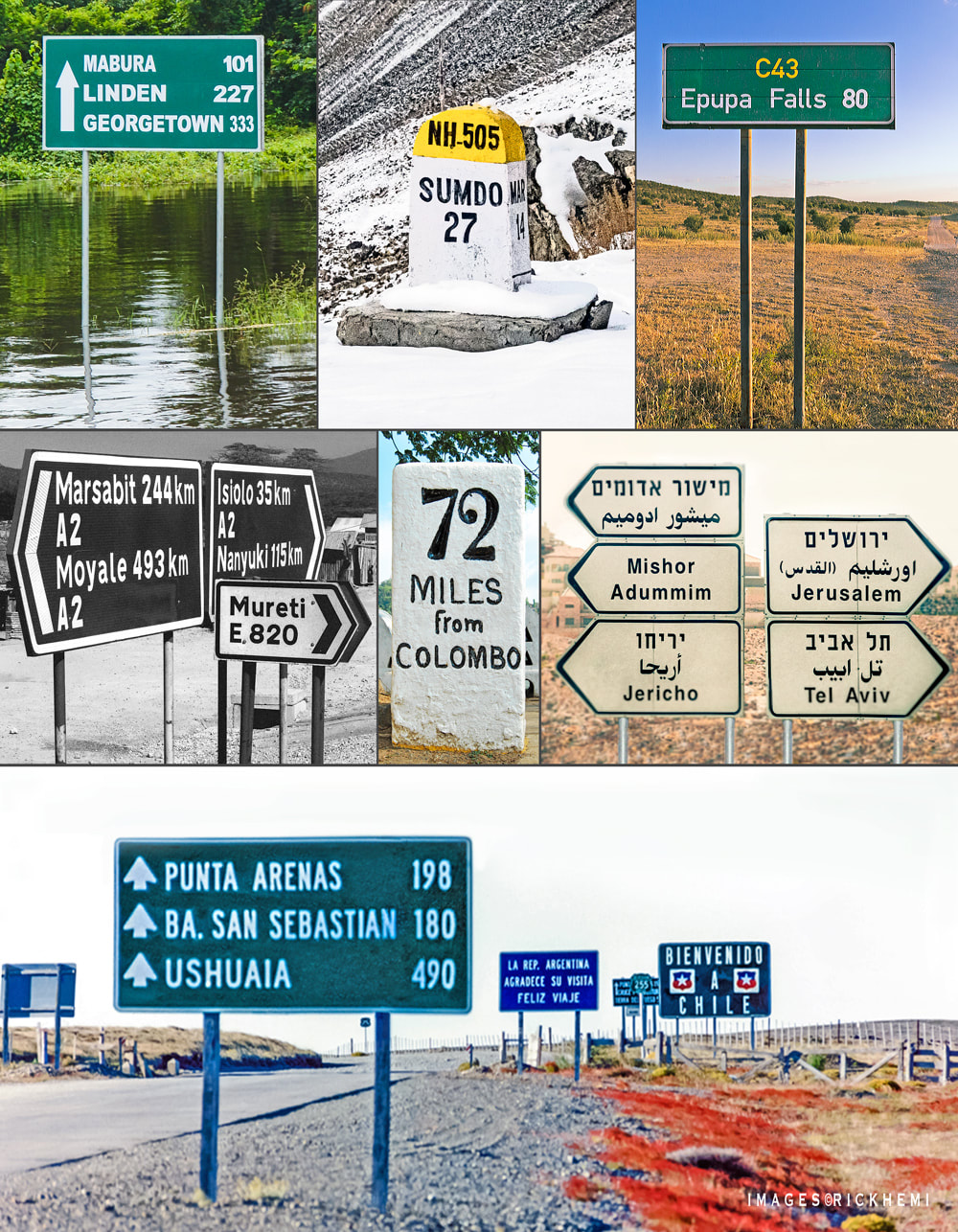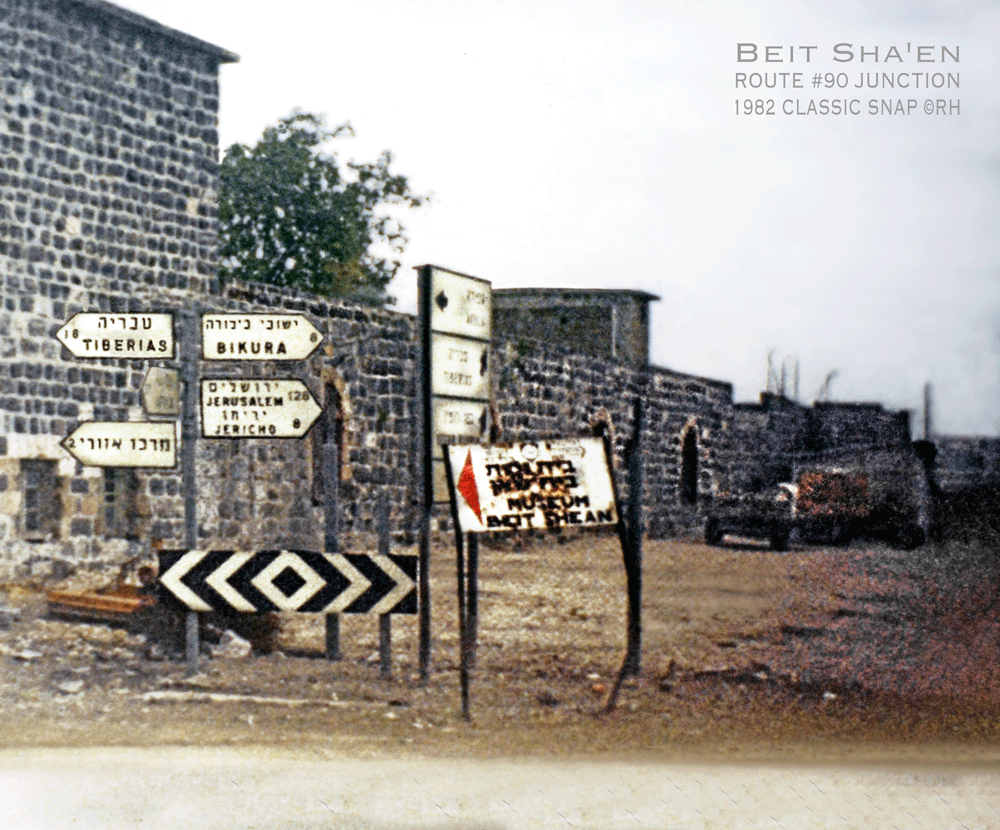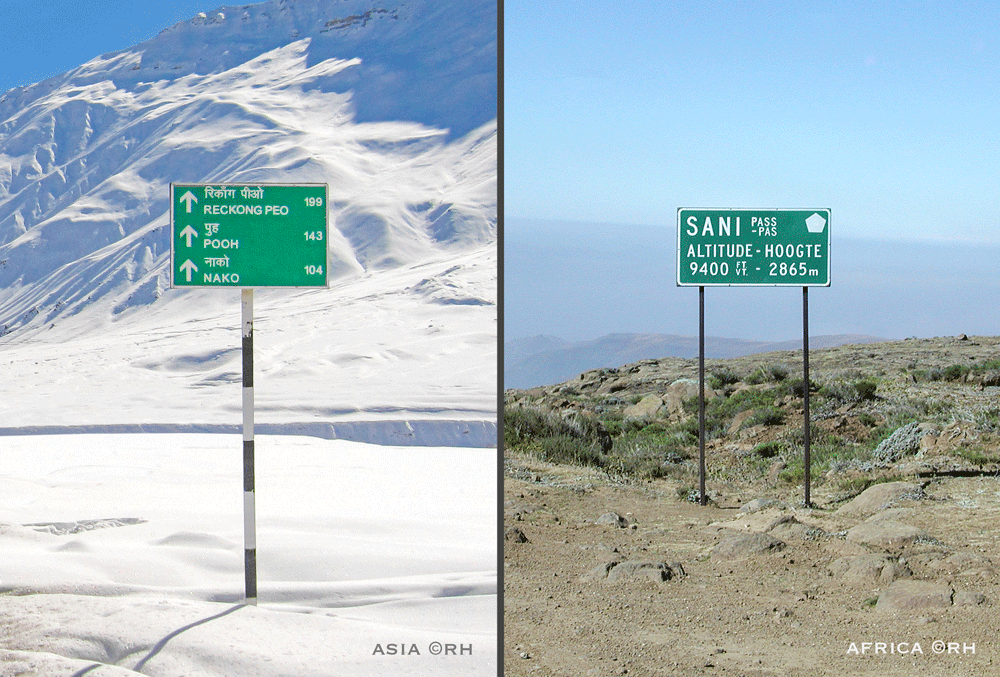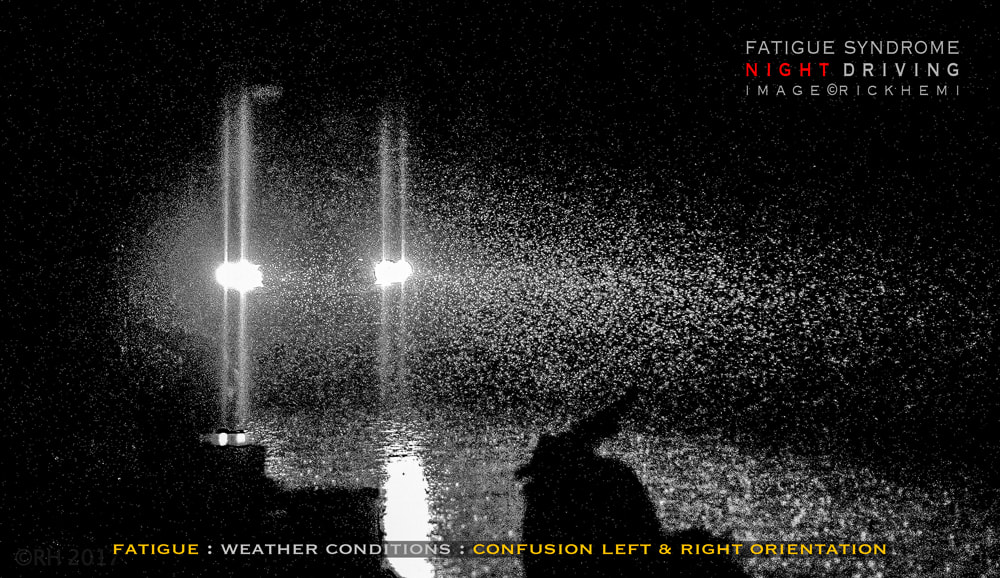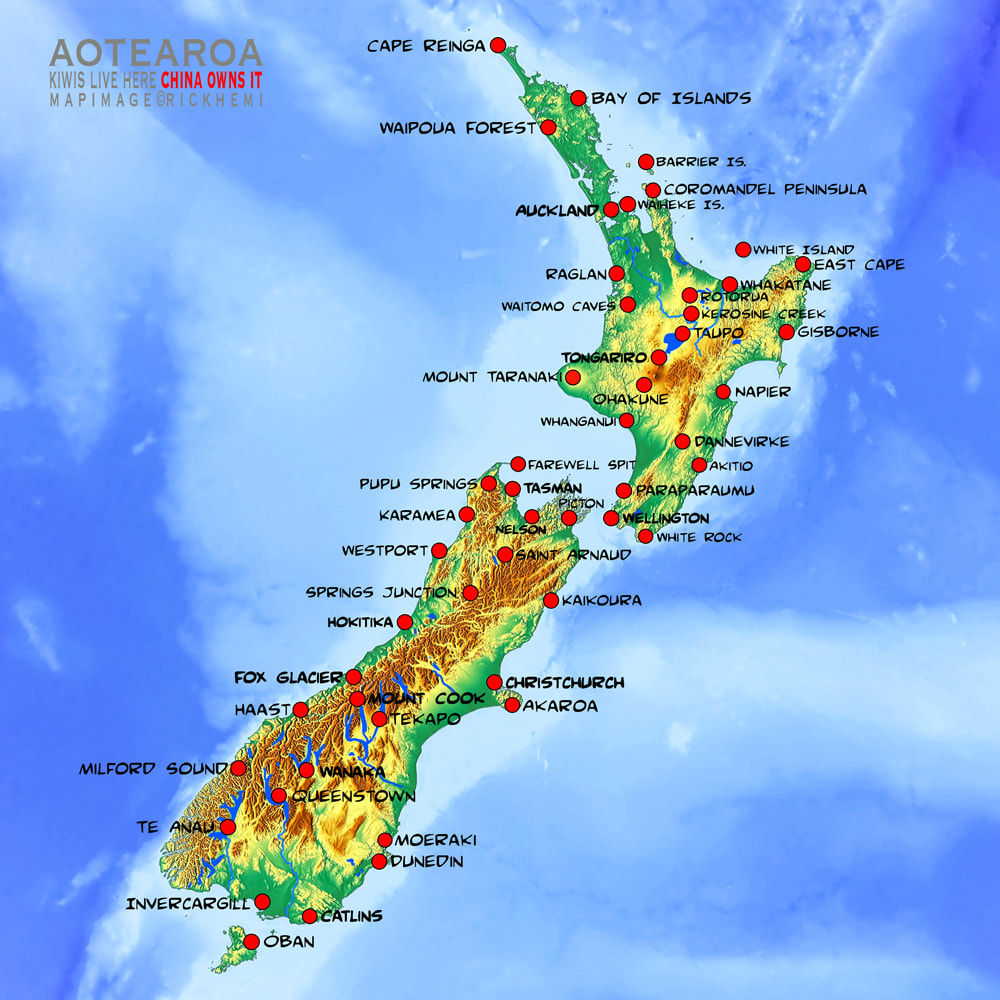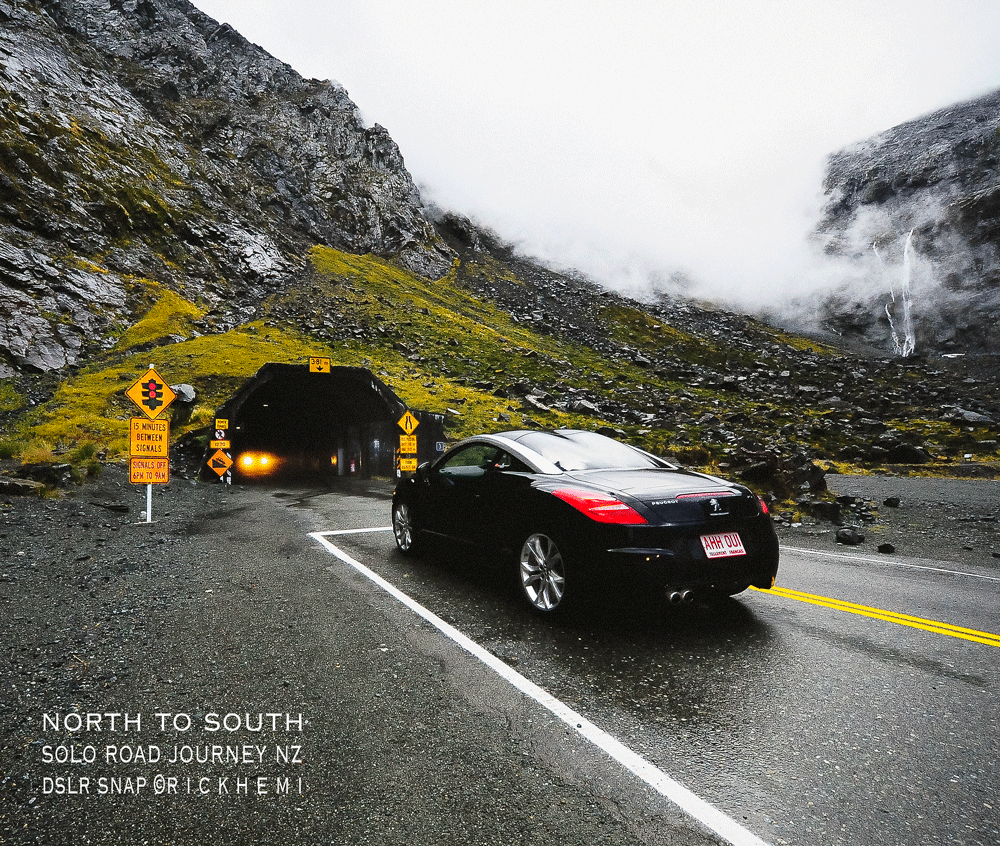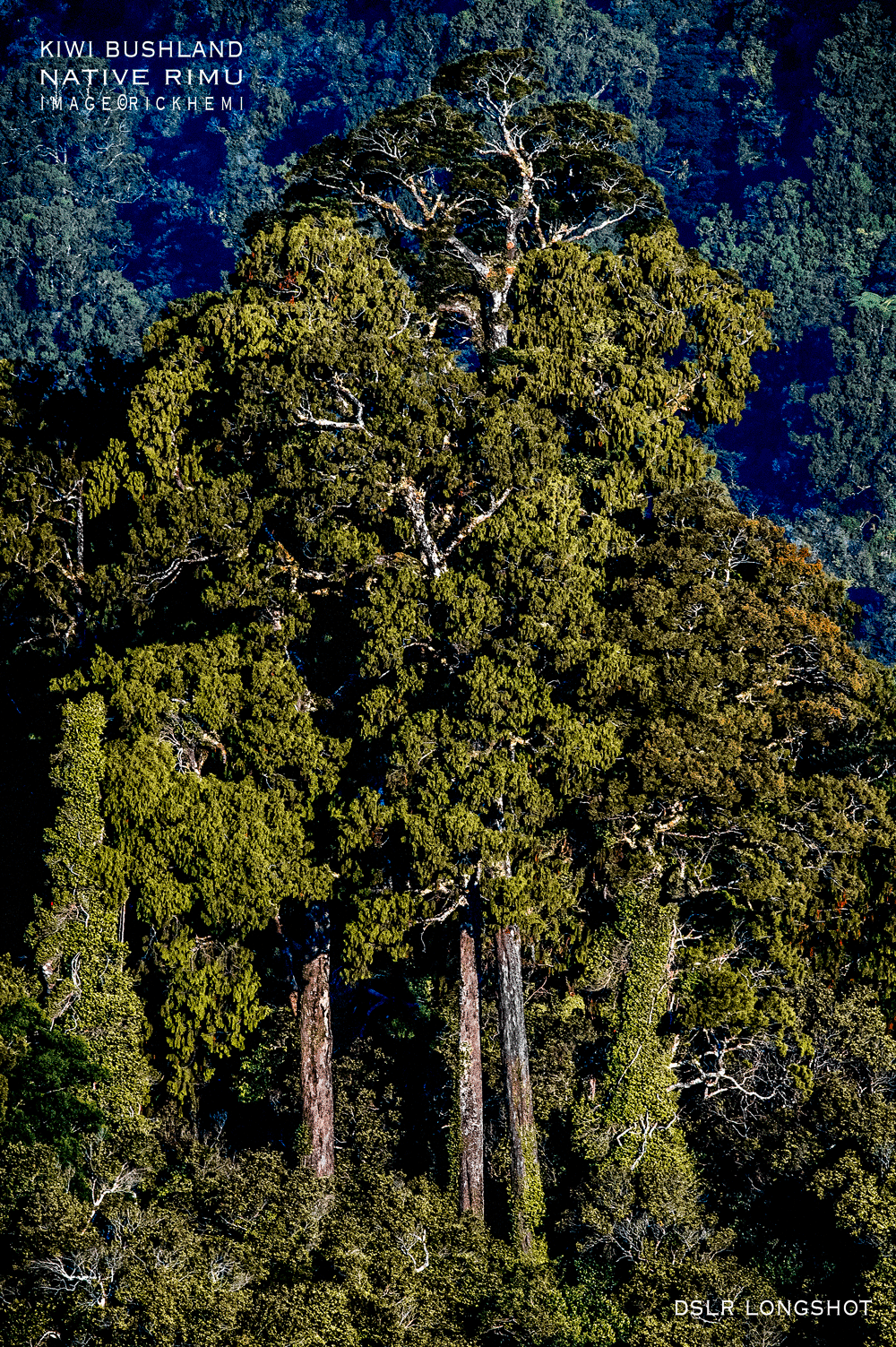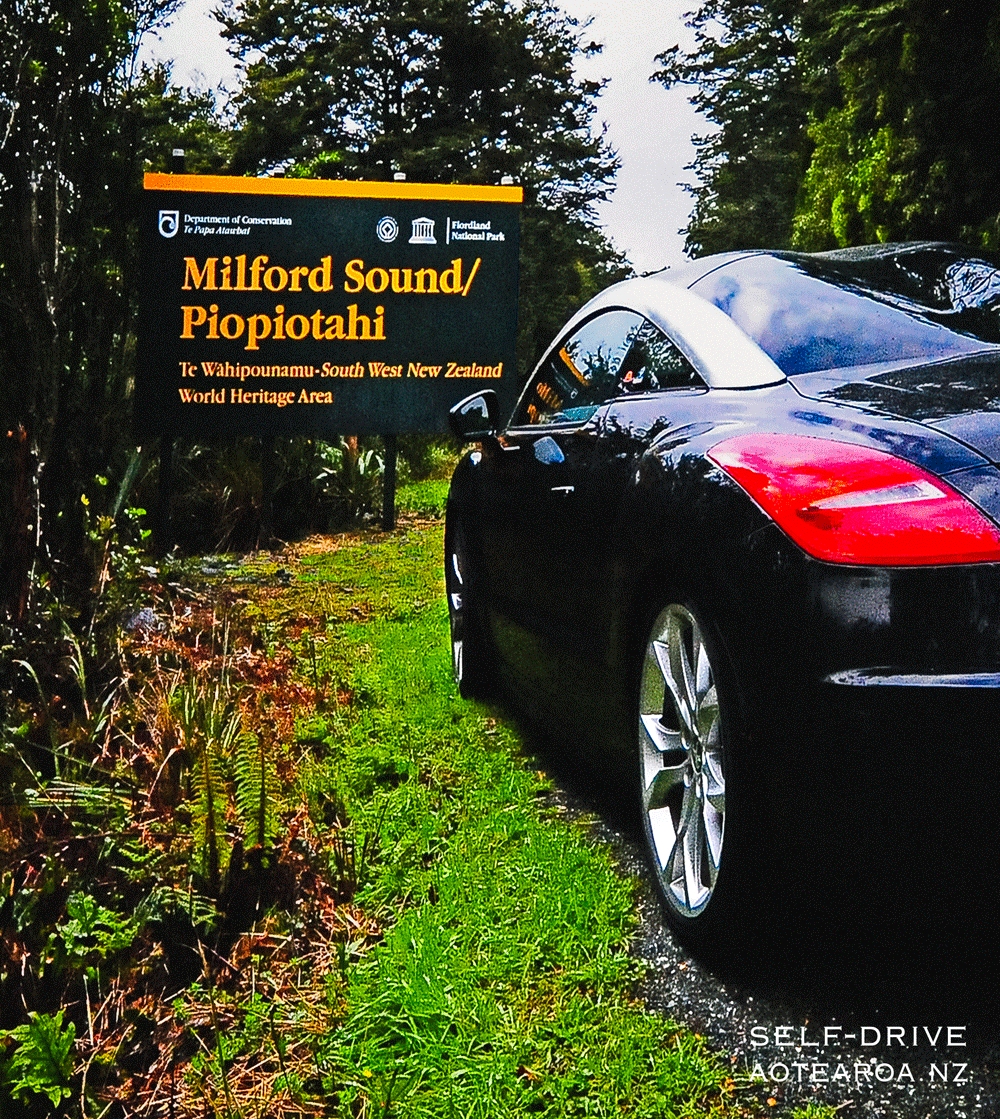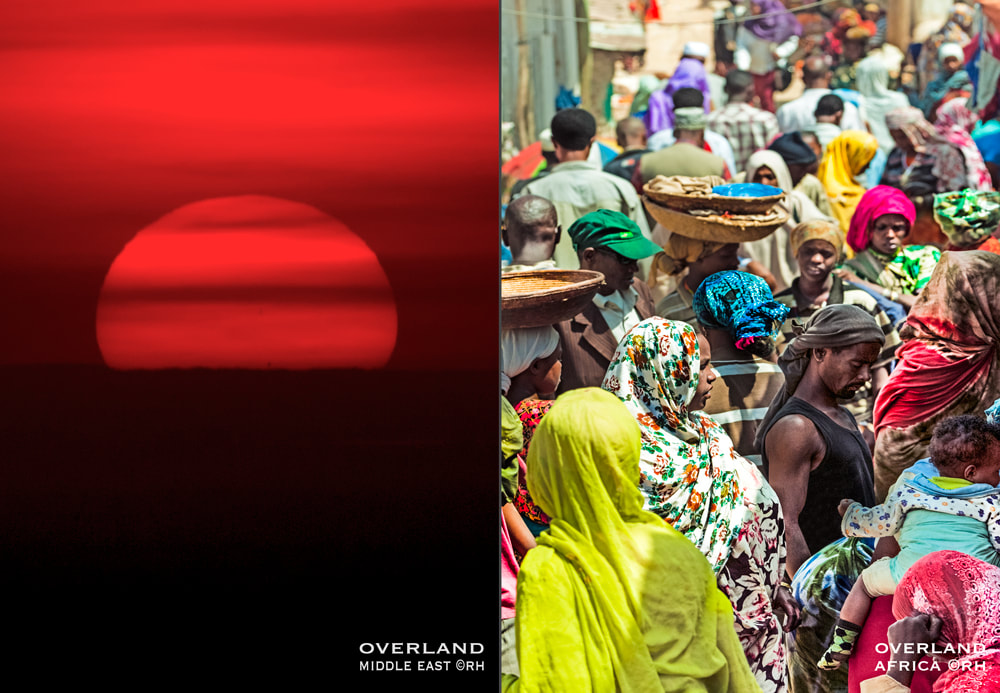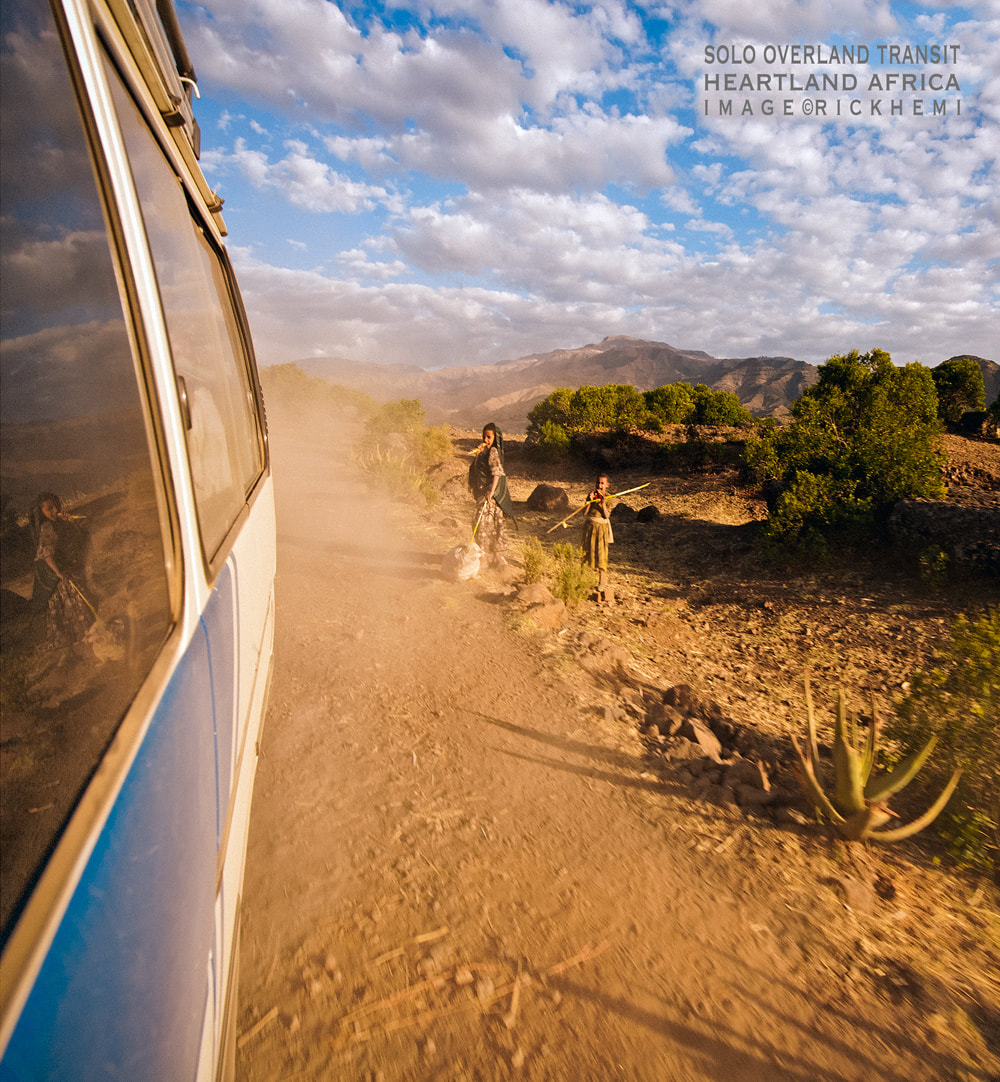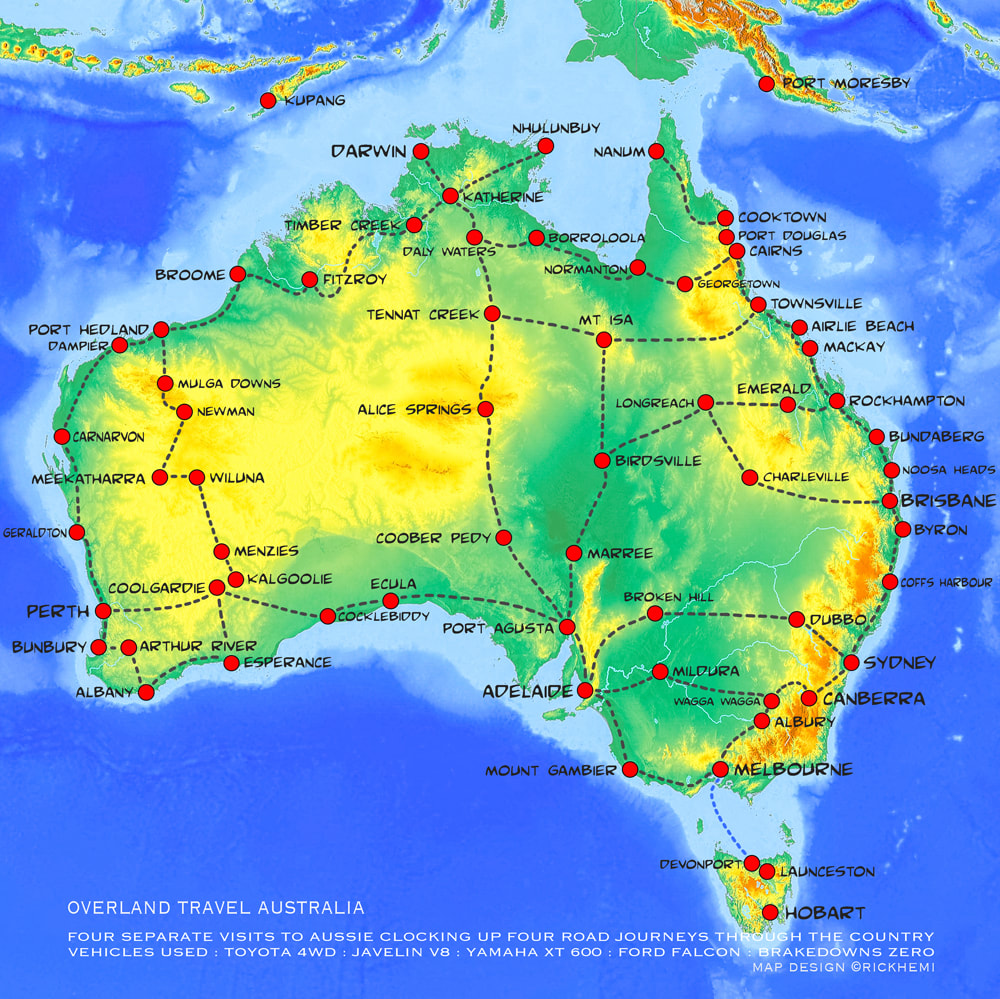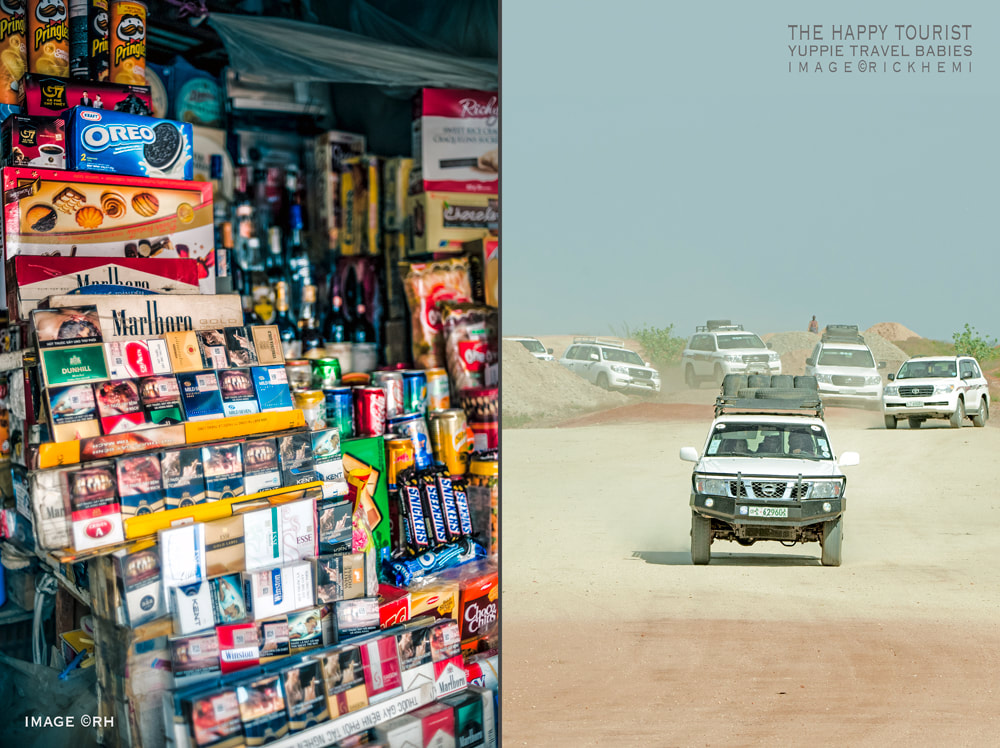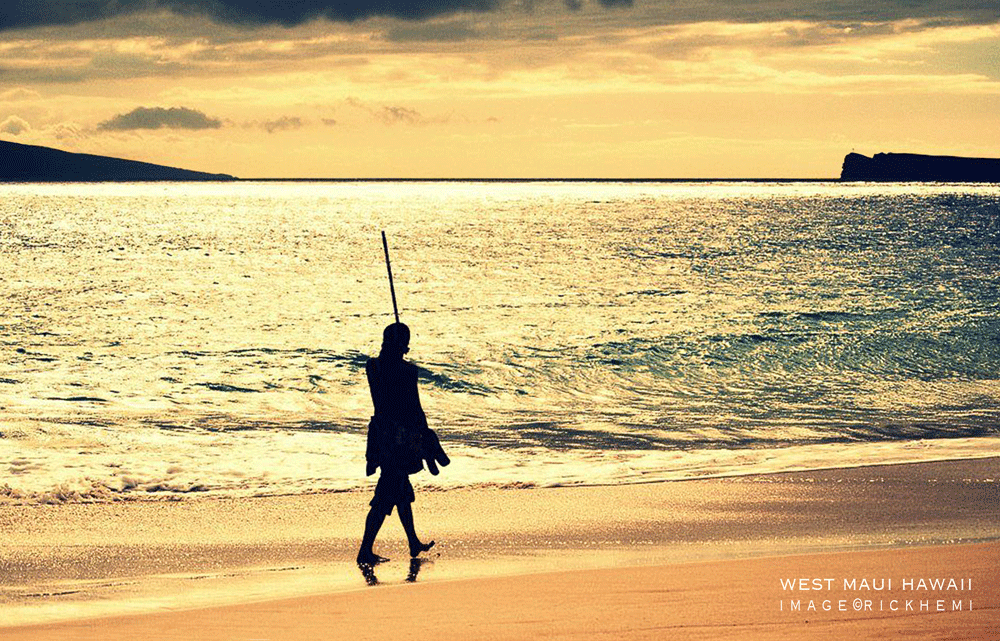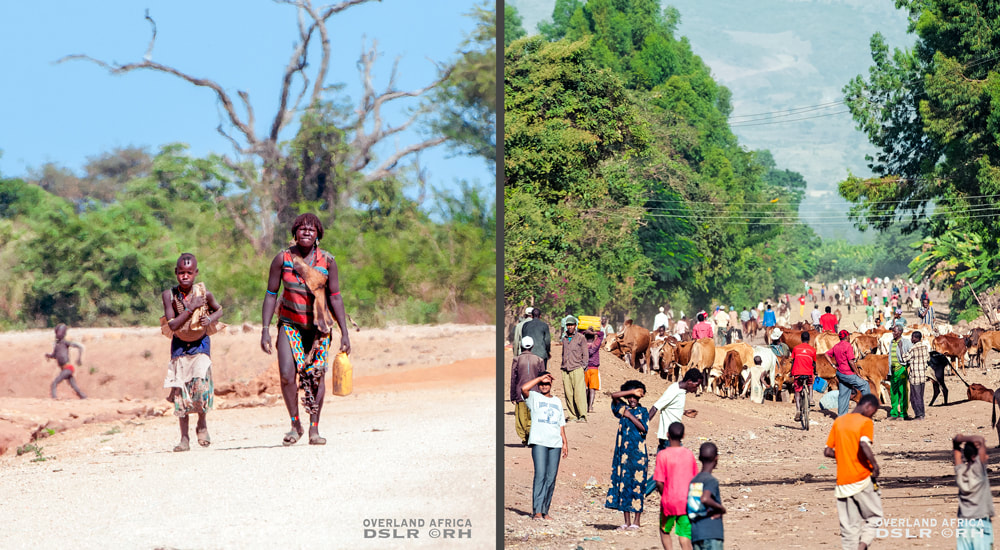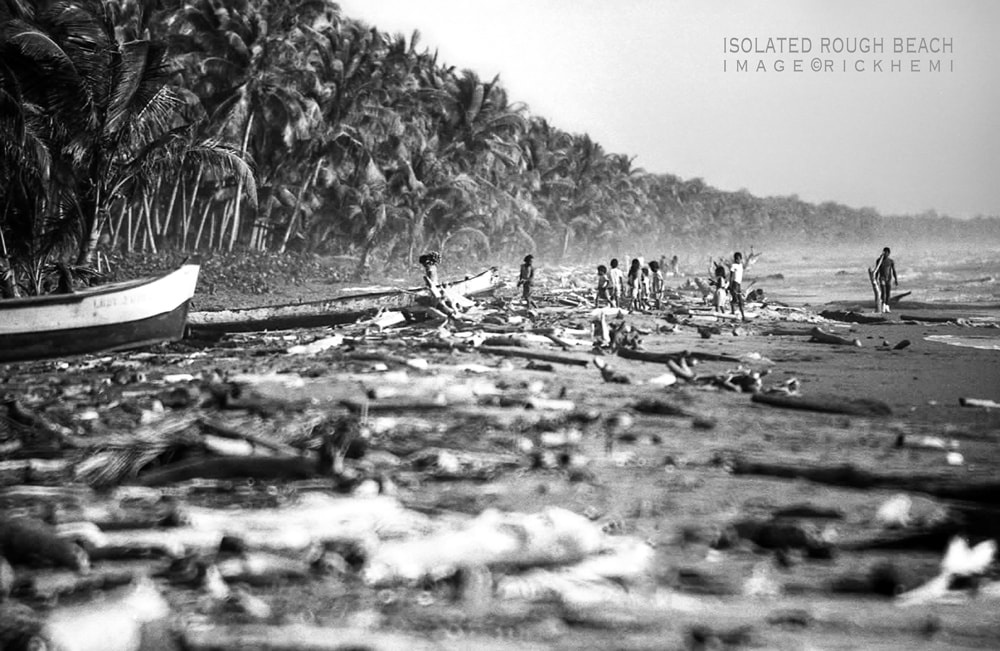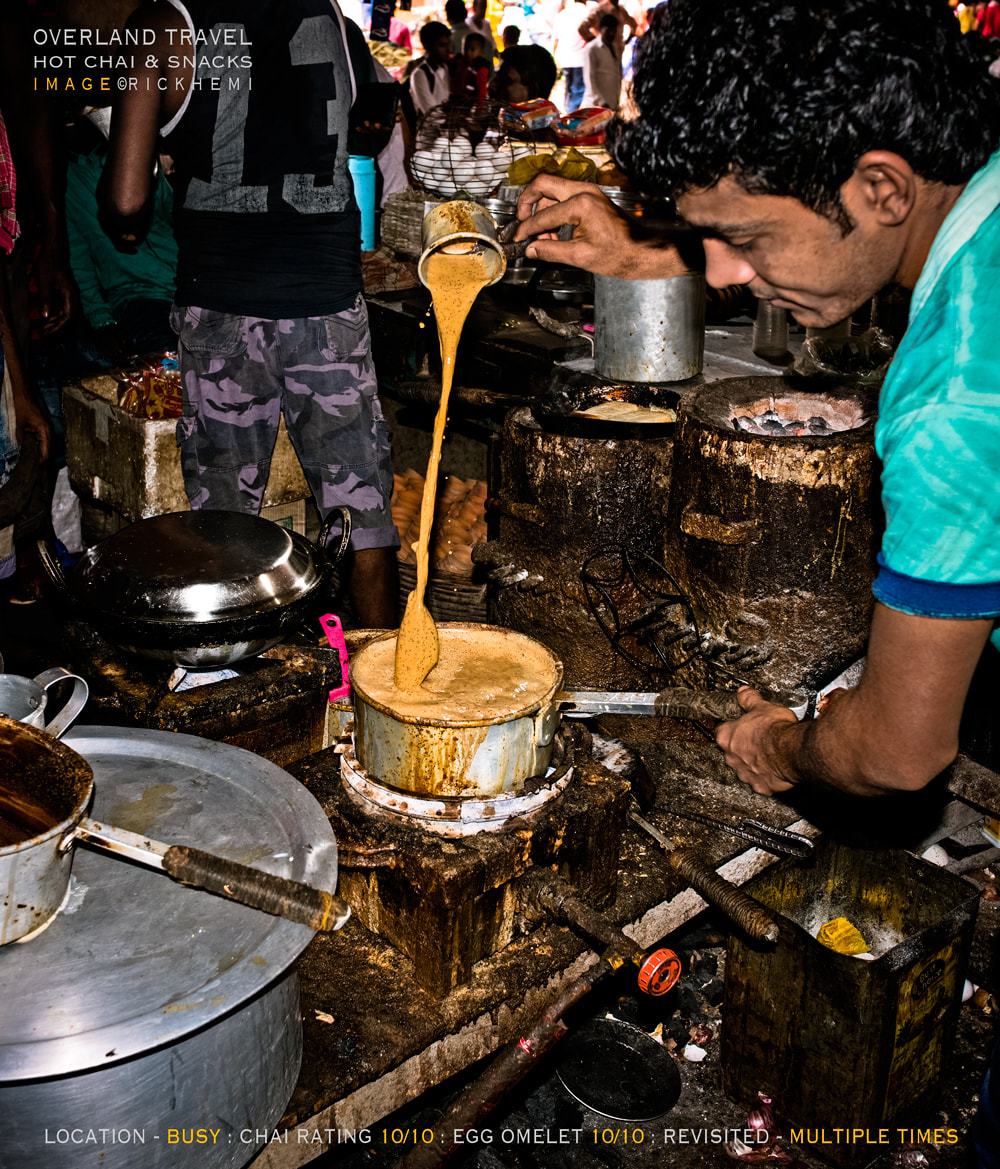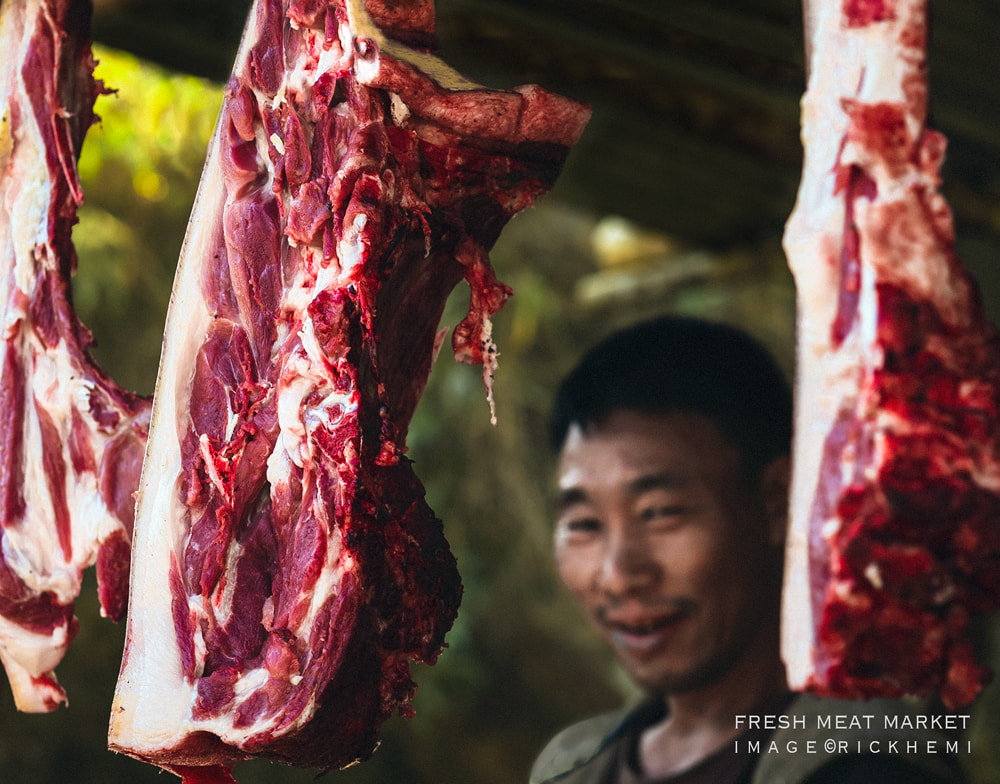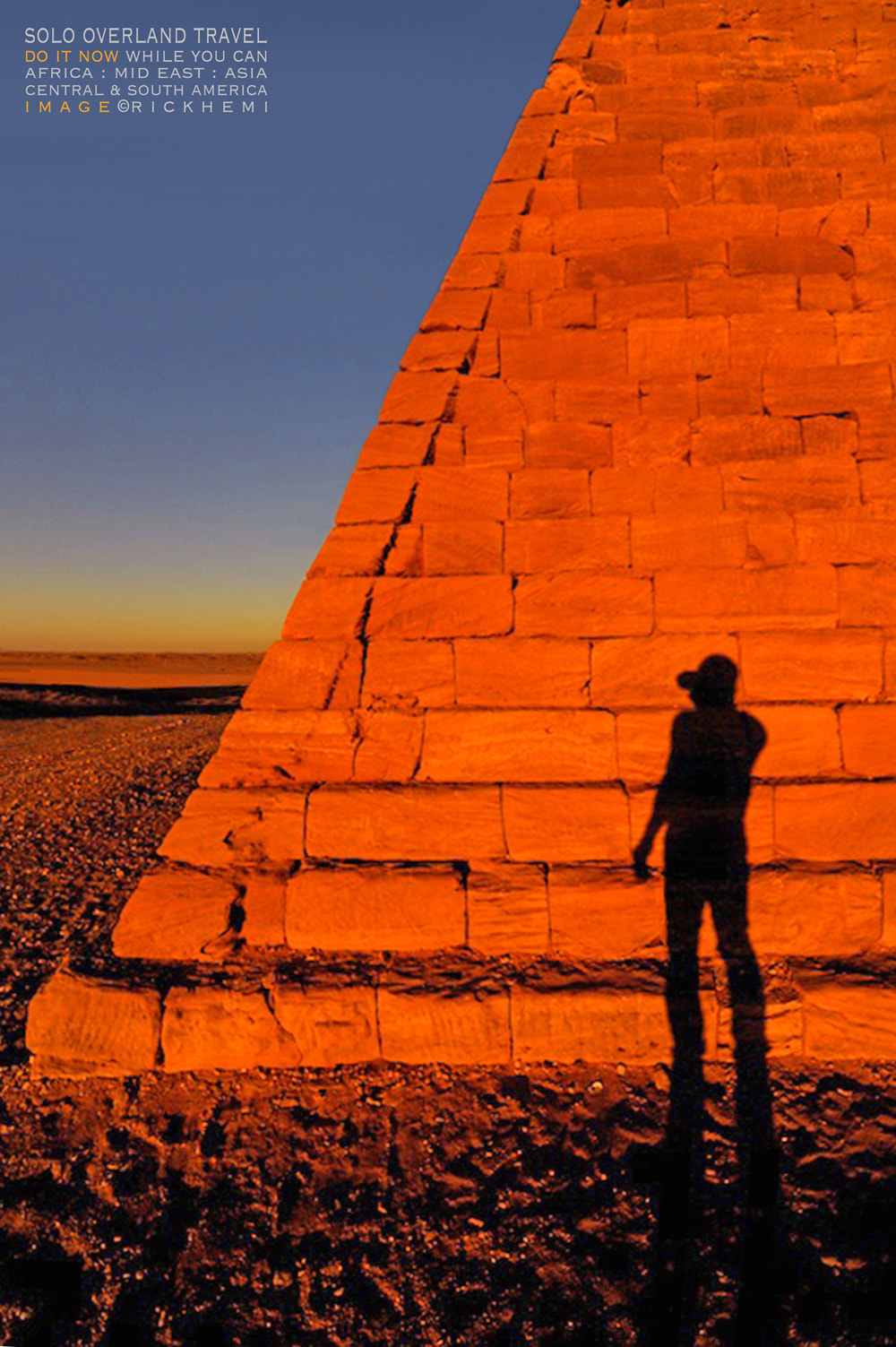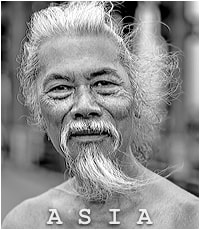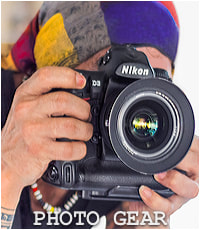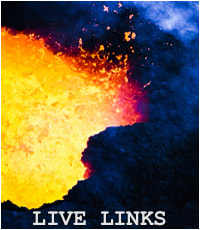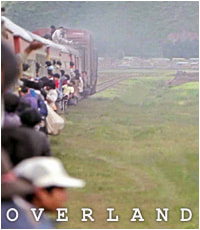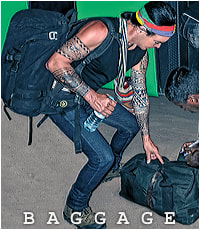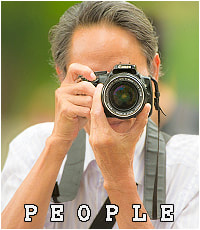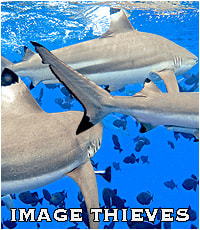Intrepid Overland Travel
Overland - Travel & Transit Maps
South America : Africa : Middle East : Asia
All Images & Maps By Rick Hemi
All my overland transit maps are directional routes through countries with connecting land border crossings. Overland transit routes throughout the planet have never changed from their original origins dating back centuries ago. Transit routes and border crossings into or through sensitive areas and tribal zones i.e. NWF Pakistan, Afghanistan, the Sahel, Magreb, Darfur, southern Somalia, north eastern DRC, Syria etc is at your own risk. Traveling on transit routes into countries with high levels of conflict containing Islamic militia insurgency is also at your own risk. Each day of travel through the above regions will have different outcomes on any given day. Ensure entry stamps have correct validity before heading off into the wilderness. Having no official entry stamp will give all types of issues further down the road you don't want to experience i.e. random highway control checks, accommodation passport checks, and random police and military spot checks. I've seen this happen on many occasions with western nationals who had crossed land borders without receiving entry stamps. If certain isolated border crossings are closed, find another official entry point to enter. In volatile countries, borders close, borders reopen, and borders can remain permanently shut for months on end. Collecting fresh up to date information before traveling through hot spot regions is necessary to know what's up ahead to calculate the travel risk factor involved. Avoid trusting old outdated information from all travel guide books, or from online small talk dribble unless it's freshly been verified. Militants, militia groups, rebels, fanatics and road bandits are always on the move expanding across countries sporadically invading new territories. Taking risks traveling into militant controlled regions should be avoided unless you're wanting to experience how it really feels to be brutalized without mercy. Western foreigners are easy targets from the countless snitches in the game looking for fast bucks. Take this information as positive advice.
1 - Get a fresh passport 2 - Renew your driver license, get an international drivers license 3 - Have sufficient backup cash 4 - Fly one way out from western nations 5 - Learn how to interact positively with total strangers 6 - Learn to agree even though you disagree 7 - Know in advance where Red Zones are located 8 - Don't become a drug addict or drug mule offshore 9 - Travel with real photo gear, not just with smart phone junk.
Those who haven't experienced transiting offshore onboard rough rugged bush buses, or hitched random lifts on the back of trucks, or ridden MC's through the Real World haven't accomplished what overland travel is all about. Nothing beats basic overland transportation. Each overland journey contains its own vibe at its own rhythm and pace. Only you decide what transport suits your needs to get from A to B.
Time limits has no place here. Take it from me, I've been doing this type of travel for decades. Don't just think about it. Do it now while freedom to do so still exists. By 2030 freedom will become a thing of the past — Pipe dreams of the old world that were taken for granted. Below image snap captured onboard the back of a hitched truck lift through the middle of nowhere @4900 meters altitude.
Inspirational solo overland journeys are within environs completely different to your own. Traveling overland through continents opens your mind experiencing different daily occurrences one personally confronts with. We're not talking about narcissistic smartphone selfie snaps in front of the Eiffel tower, or beach snaps taken in Bali, Belize, or Rio. They are worth a dime a dozen and nothing more. Now I've probably upset some out there, this website isn't about social media Ego likes. Solo overland travel offshore has more depth than just flying to Paris or Bali. Capturing quick snaps on the go through the middle of nowhere, like below onboard moving bush buses and trucks in transit crossing continents add inspirational value. The most universal item traveling offshore in the 2020s, are cameras — not smartphone junk. Avoid becoming a sheep following other sheep. Instead, travel using real camera gear.
Overland transit high altitude on dirt highways like above are still found and used through the Andes and Himalaya chain. Below, main dirt highway route, central Africa, overland coast to coast using any available basic bush transport.
Overland Transit - Amazon Basin
The most difficult decision transiting through the Amazon region, is which direction to begin and end any comprehensive journey. There's certainly no way of completing all the following transit routes in one hit, unless one has plenty of time on their hands reaching different start locations. There's five main transit river routes, including other optional river passage ways criss-crossing through the basin. From Colombia, grabbing a slow boat from Puerto Asis to Letica down the Putumayo will give options to continue up or down the Amazon through to Pucallpa or Belem.
From Ecuador, riverboat journeys usually start at Coca, this is a straight forward ferryboat route to Iquitos, with connections onward to Yurimaguas, Pucallpa, and further south to San Francisco using private passage.
Brazil has multiple up and down river ferry routes through the entire Amazon basin. Belem to Santarem, Itaituba, Jacareacanga, Manaus to Tabatinga, Manaus to Boa vista and Porto Velho, or up river to Cucui into Venezuela. Short ferry boat journeys to Maraba and Macapa are optional.
One of the best, but most difficult routes worth mentioning begins along the Orinoco river from Ciudad Guayana-Venezuela to Manaus, taking approximately 6 weeks to complete. The southern gateway of Venezuela along the Colombian-Brazilian border is a notorious drug smuggling region - watch your stuff!
Overland Travel - Camera Gear
The big question, is what kind of camera gear is sustainable for everyday use and remains reliable throughout long term overland journeys. By researching, one finds DSLR photo gear is still the most versatile equipment hands down. I'm not here promoting DSLR's are better than lighter weight 3/4 cameras or upmarket point and shoots. In saying that, through the decades, I've used numerous different camera formats with 6x7cm being the largest. Semi and pro full frame DSLR cameras have been the best of all them for travel. Full frame DSLR lenses whether fixed primes or zoom are hard to beat. Some of the best reliable DSLR photo gear are certainly not what's selling on the retail market today. The climax of DSLR cameras peaked around 2017. Many full frame DSLR lenses from 2006 up are still good performers in the 2020s. Even a few classic fixed prime manual lenses from the 1980s work well on full frame DSLR bodies.
The difference of non-interacting and interacting with subjects is clearly seen above. Seasoned street photographers, like myself, will capture more subjects looking into the lens. All it takes, is a little positive dialogue with subjects first. It might take two, maybe ten minutes, who cares how long it takes capturing street portraits , and what's the rush? There is no rush.
If it works — use it. The above AF 85mm 1.4D prime has captured thousands of people shots since 2012. The need of another portrait lens isn't required until this 1995 85 prime kicks the bucket. Nikon's older prime lenses were made to last. I don't follow 'newer is better', I use what still captures good still images. Even the above 85mm snap was taken with a 50mm 1.4 AIS manual prime. Personally, I avoid using fixed lens point and shoots for street portraits and people shots. Some swear by them as their travel camera. I use them for location snaps instead of smartphone junk.
How's your overland travel camera gear going? 2007 12MP Nikon D3 street still — 2020s
It's all about what can be captured giving satisfactory end results. There is no one lens does all, believe me, I've been down that road of regret. The focus point here, is what can capture all kinds of subject matter i.e. street portraits, landscape, distant wildlife, moving subjects, astro, and on the go diverse snaps maintaining the same outcome - quality finished still images. Forget about fancy 3 lens smart phones. Those relying on junky smart phones for offshore travel are usually addicted social media addicts. Do your own research of what kind of camera gear is most versatile capturing stills beyond your own limitations.
If your camera gear can capture lunar shots like above, your camera gear has no issues capturing anything through the planet with ease. Don't fall for the usual hype that everything newer outranks older photo gear stuff. More lunar images by the website owner here.
Location snaps doing something, like capturing images has more depth than selfies. Below, typical rugged highland landscape.
If I had instead written the below image was taken with modern camera gear, most would probably believe it. The deception of 'newer is better' has been in full swing, since the mid-1980s. Traveling with lightweight cameras, over-loaded with 'user friendly features', 60MP, including tilt screens, GPS, wifi and bluetooth doesn't make a still image any better. This creates more of a burden, a slave to the very opposite of what still photography is actually all about. Do you really think your two year old camera is outdated, because ten new replacement models have hit the market? Only fools follow trends. This recent 2024 image is here for that reason — 17 year old 2007 12 MP Nikon D3, 43 year old 1981 Nikkor 80-200 f.4 AIS.
Creating the best out of still photography has little to do having the latest camera gear. If you believe that, travel with smartphones instead. Only paid sponsored photographers will tell you the need of having the newest body or lens. They will spend more time concentrating on added user friendly junk older cameras never had. All the latest add on junk isn't required capturing stills — Got it?
On location snaps using a 2007 D3 & 1981 80-200 f4 AIS, India, 2024. Body & lens weight— 2kgs : Still capture quality — excellent : Issues — none.
Heartland Africa - Overland Transit Routes
The ongoing issue over-landing through continents today, are the expansion of terror cell networks actively working through Africa, Asia, and the Mid East. Countries that were once easy to travel through have become haven filled with various terror cell groups who reestablish and relocate in different regions. Sleeper terror cells have established themselves through the African continent. Traveling through volatile regions can be risky for western nationals who let their guard down. They're easily spotted and targeted within certain locations. Snitching is common. Snitches can be hotel workers, bus and taxi drivers, or someone discreetly watching from distance. Direct confrontation will solely depend on the timing at any given location within Red Zones for the chance of becoming targeted to occur. For some westerners, hanging out in Red Zone areas may sound cool. Just remember every day within Red Zone territory is different to the next that come with unexpected nasty surprises.
2019 terror cell updates: Al Qaeda-northern Africa, Boko Haram-north eastern Nigeria, Al Qaeda-DRC, Taliban controlled regions-Afghanistan, Al-Shabab-East Africa, Baloch Liberation Army-Pakistan, Al Qaeda-northern Sinai, Al Qaeda-Syria, Islamic State-Phillipines, Terror cell-southern Thailand, Islamic State-Sri Lanka
Overland border crossings can suddenly close at anytime due to militant insurgency. Some routes shown above can be difficult to cross, or forbidden to travel for western foreigners - even if visas were issued in advance. Bribing to pass through at border crossings in Red Zone regions should be avoided at all costs. The most volatile regions as of 2022 is through the Sahel, northern Nigeria, Cameroon, Libya, Somalia, and north east DRC. Transiting overland coast to coast through this part of Africa using basic transport requires sustainable energy, time and endurance, and good interaction skills. This region of Africa is not a walk in the park - the opposite of south east Asia and South America.
Bush Bus Comfort - Basic : Wifi - Non : Air Con - Open Window : WC - Non : Noise - Plenty : Rating - 10/10
Red Zone Definition - Any region or area containing uncontrolled insurgency, local Islamic militia group, random sporadic attacks, highway armed holdups, hostage taking, drug smuggling, rebel controlled territory, direct war conflict, banditry, extortion, high risk loss of life, zero safety.
In volatile red zones, international border posts shut and close without notice, they can be permanently closed for weeks, months or even years. Due to the ongoing Islamic cloud spreading through north and central Africa, many overland routes and border crossings shown above may, or may not be open allowing transit for foreign nationals. Depending on individual border crossings, it's the discretion of immigration officials granting entry. In the middle of nowhere border posts use their own rule book. Cash bribe payments may be on offer. This is entirely up to those wanting to fork out bundles of cash to continue their journeys. Large swaths of territory surrounding the Sahel region is as volatile, or worse than the inner Sahel region. As usual, all onward visas should be in order. Transit routes above are at your own peril. Below, on board a bush bus hauling on a freshly finished Chinese belt & road route snaking through the middle of nowhere.
Overland transit routes into Syria from Turkey onward through to Lebanon, Jordan and Iraq. Syrian visas can be processed at consulates & embassies. Border visas on arrival require security clearance. This is done through affiliated travel agencies booking a tour. Passports should have no Israeli stamps, including single one way Egyptian Jordanian entries. This includes any memorabilia from Israel i.e. Hebrew markings, shekels, stamps, including smartphone images, and past related online hotel bookings and accommodation connected in Israel. Syrian border customs will go through all the usual searches, and will deny entry if any of the mentioned above is found. Red Zones still exist in Syria. It's at your own risk traveling within designated regions where random attacks may occur. Avoid returning home in a body bag!
Solo Overland Transit - Middle East
Middle East Red Zones move change and relocate through the region. It's up to the individual traveler to source fresh news of what's up ahead before rushing from one location to another through the middle of nowhere. I gave up with travel insurance decades ago. Those who do travel with some form of travel insurance should check the small print in their policies. Above image, an airstrike showing collateral damage.
Vessel transportation through the Mid East is still working effectively from established ports. Purchasing one way voyage births are issued with valid visas entering designated ports of call. A few to mention, Suez - Duba, Port Sudan - Jeddah, Gwader - Muscat, Bandar Abbas - Doha, Aden - Djibouti. Above snap, a second sailing on the same vessel with the best sleeping location above the bridge. More on cargo passage vessels in the overland transit page.
Traveling through the Mid-East, is just like anywhere else on the planet. Transportation choices depends on location. The more isolated, the more basic transport becomes. Personally, I'll use anything with wheels going in the right direction. Hitching lifts are at the normal spots i.e. gas fill stations, and at international border crossings. Those having Israeli stamps in passports require fresh passports when entering Lebanon, Syria, Iraq, Iran, Saudi, Yemen, Oman and Kuwait, until further peace initiatives are established.
Longest auto rickshaw journey with baggage — 6 hours. Longest hired rickshaw — 3 days. Roughest rickshaw ride since 1982 — Syria
Bolivia requires minimum of two months travel time. Self-driving your own 4WD vehicle is highly recommended.
The great outdoor wilderness can't be ignored, it's out there everywhere. The only thing required, is the time reaching them.
Hiking and trekking through wildness regions around the planet beats lying on beaches all day. The ultimate climax, is when local wildlife casually stroll right in front of you, like these Himalayan snow leopards.
All the below locations are good locations for spotting snow leopards during midwinter — not just the Kibber region! Those into group travel tours who can't be bothered self-tracking and spotting snow leopards on their own usually end up in Kibber. It's up to the individual whether they want to pay over-excessive rates via travel agencies, or go it alone. I grabbed a local driver that was familiar with the terrain, and succeeded self-tracking, self-spotting, and photographing snow leopards outside of the Kibber region. This also avoids paying unneeded Mafia Tax when taking roadside snaps, or when setting up camera gear along the Chichim Kibber road route!
Japan - Ferry Boat Connections
From Russia, there is the option of reaching Japan with ferry sailings from Vladivostok. Heading in the other direction, Vladivostok connects the Trans Siberian through to Moscow and on to Europe. Several ferry boats sail each week to Busan-South Korea from Shimonasaki port, Japan. There are also direct ferry boats to Shanghai from Osaka port. The Okinawa-Keelung Taiwan route no longer exists, but boats do sail every week from China to Taiwan. Ferry boats also connect Taiwan and the Philippines. Reaching Malaysia from the Philippines can be done from Bataraza, Palawan by fast cat ferry sailing to Kudat Port, Malaysia. I've traveled extensively through Japan on 3 different visits. Hitching, and purchasing a van are the best options getting through the country.
Is Taiwan worth the extra mileage and time? Yes! At full speed getting through the country takes a month, at slow pace, two months. You can see Taiwan was well ahead in tourism from the illustrated map below, published by Mei Kuang Art Company, 1954, author Baishou Xie. It puts my own maps to shame. This is why it's here — this 70+ year old map gets a 10/10 rating. Taiwan travel info.
There's always one vessel journey that sticks out from all the rest. The slow going cargo passenger ship Liemba is it. One of the oldest ships still operating with a rich history dating back to 1913. The off-loading on-loading of cargo and passengers is done offshore. Hustle and bustle on board the Liemba beats Antarctica, Mediterranean, Caribbean and Pacific cruise liners hands down. Above image, the Liemba's stern side during transit.
Overland - Use Cameras Not Smartphone Junk.
If anyone gave me the latest high tech smartphone for photography, I would probably leave it switched off, and instead keep using what I've been using capturing stills — DSLR photo gear. That's how much I don't like them and don't need them — for anything!
If I can capture bird & wildlife image snaps, just like these quick examples — so can you!
Typical wetland ambience in the middle of nowhere using DSLR photo gear capturing stills from long distance. Leaving continents with satisfied still images of people shots, street snaps, closeup portraits, bird and wildlife, is done using real camera gear.
Most gave up using Nikon's earlier DSLR full frame bodies years ago. I'm still using them in the 2020s for different kinds of overland travel still photography. The above image (low res website image only) was taken with a 2009 D3S, in DX mode with a 38 year old Nikon 1986 manual AIS prime lens — 75% cropped & enlarged from the original RAW NEF file. If your camera gear can produce 6MP crop enlargements, like above, what's the problem? There is no problem — use it!
Within hinterlands and highlands, it's random people shots like above and below that I personally enjoy capturing.
The rush running out at full speed getting the latest photo gear, is like the fashion industry. Everything newer is better than older stuff — Really? The street portrait below was taken with a 1986 Nikkor 800 5.6 ED AIS manual focus lens and DSLR 2007 Nikon 12MP D3, from 30 meters distance. How about that? For fun, the image was entered into a pro-photo competition, wait for it, it won best portrait. Don't be deceived everything newer with photo gear is better. For video, yes, and all those user friendly settings for the Gen Z. Some of the best camera designs and full frame lenses for still photography have already been made.
Street portrait — 2007 Nikon D3 12MP, 1986 Nikkor 800 5.6 AIS manual focus lens — Don't tell me about having more megapixels!
Solo Overland - Camera Gear Stuff
The first rule even before heading offshore, is knowing the capabilities and weaknesses of your camera gear. Thoroughly testing out stuff becoming familiar with photo gear makes it far less inconvenient further down the road. Replacing subpar lenses and bodies should be done at home base before travel. Keeping photo gear in good usable condition during overland journeys through any continent, is by what baggage and protection is being used. The lesser protection, the more vulnerable stuff becomes. Dust, dirt, grime, wet soaked lenses can't be avoided within many environments. It's up to the camera user keeping up to scratch maintenance with photo gear. Ignoring the simplest blower brush wipe downs will end up with all types of issues within a short time period. Fungus spores in lenses begin from the lack of maintenance. Simply just laziness. Dropping cameras and lenses, is something I've personally never encountered through decades of travel. I've met others on the road that have, ending up with damaged bodies, cracked lenses and glass etc. Good quality camera gear lasts for years, if maintained properly during overland travel journeys. The top left image, an AFS-200-400 f4G VRII has been used since 2010, and still working perfectly in the 2020s. Including D3, and D3S bodies. The top right, is the the AFS 600 F4 in the lower image. The lens received a full service by Nikon, Tokyo. Some of the best reliable camera gear for still photography was made more than a decade ago. I don't follow the megapixel bandwagon, and as for smartphone cameras — Avoid them as substitute cameras.
The one lens does all theory, is more than mythical. Smart phone travelers have hijacked that myth. Heavily cropped enlargements from original files captured 400+ meters away using short focal lenses will end up more than disappointing. I know, because I've been down that path a few times through the decades. Today, in the 2020s, it's simple to find a series of quality used lenses at affordable prices. Off course, one has to decide what is enough photo gear on the road. If you're into wildlife, landscape, street portraits, lunar and astro, you'll need the right stuff getting satisfactory results. Above snap, real maps and photo gear that was used through South America, including Guyana, Suriname, Guiana and Venezuela with no damage or loss. (2 full frame Nikon DSLRs, 1 point & shoot, AFS 600 F4 ED, AFS 70-200 2.8G VR, AFS Micro 105 2.8G ED, AF 50 F1.4D, AFS 14-24 F2.8G, AF 10.5 F2.8G ED)
Arrival by air is best at either end of the continent. This lessons of passing through regions already traveled. South America overland requires minimum of 12-18 months, and that's pushing it. Brazil & Venezuela are still the best countries to purchase gasoline and diesel vehicles for travel. You don't need the latest vehicles, just commonly used models that have surplus parts of inventory, if required. Avoid self-driving through the continent after dark!
Although I've used local transport, hitched and driven 4WD's through Namibia, the best method getting through this amazing country, is self-driving. Renting a good 4WD' isn't at all cheap. Negotiating for periods of more than two months will give the best rate.
The enjoyment photographing birds certainly isn't on everyone's bucket list. It takes considerable time, years of travel developing the urge further into bird photography. We're not talking pro here, just the needed camera gear that's able to capture birds from distance. Most full frame camera bodies (DSLR or Mirrorless) with quality made lenses, is sufficient enough. Anyone looking for affordable used camera gear can browse through KEH camera's large inventory.
Spending timeout under the surface of oceans, is certainly an addictive past time when on coastlines. Diving requires levels of certification for your own safety. Avoid diving into oceans beyond reefs without prior knowledge of safety skills. An open water dive (OWD), or advanced open water dive (AOWD) certificate will allow free diving down to 30 meters. For underwater snaps, the GoPro Hero is probably the best camera for stills and video. Ensure cameras are safety latched to the body within deep water. All cameras when used underwater have limited depths handling pressure. Even GoPro cameras have exploded or ended up with cracked glass. Also avoid using SD cards already full of other images and video. Use empty SD cards on each dive.
Use real camera gear for bird & wildlife — Altiplano Flamingos, South America.
The ultimate locations capturing images, like above, are within wetland and swampland regions through the continents. Migratory birds are normally spotted during the cooler months on both sides of the equator. Image — DSLR, manual focus AIS prime, tripod.
Full frame DSLR bodies and upmarket prime and zoom lenses are worth their weight. If I didn't use them myself, most images captures through this website wouldn't be here. At the end of the day, it's an individual preference what camera gear one travels with. Try to avoid using what many think is trendy, but useless in real time — smartphone junk.
Those into all kinds of street photography will have difficulty to find other countries that India has to offer. India is a street photographers paradise. These random still shots shows India's vibrant atmosphere. Capturing people shots and diverse street images within bustling markets is rewarding. I personally use full frame DSLR camera gear, although quality upmarket point & shoots and 4/3 cameras will do the job (not smartphone junk).
Early morning 450m longshot taken from across the Ganga — DSLR, AIS manual focus prime, tripod.
Suggested Indian overland travel itinerary : Arrival Myanmar border, Nagaland, Assam, Arunachal Pradesh, Assam, (Bhutan) Sikkim, Meghalaya Tripura, Mezorim, (Bangladesh), West Bengal, Orissa, Andhra Pradesh, Tamil Nadu, Kerala, Kanataka, Goa, Maharashtra, Gujarat, Rajasthan, Punjab, Himachal Pradesh, Kashmir, Himachal Pradesh, Uttaranchal, Uttar Predesh, exit to Nepal. Ezilon Indian map
Three random image captures through three different decades : Travel time required for India - six months minimum.
You don't come to India only to then take internal flights. That's not real travel, instead, use overland transportation through the country.
Many ask why I'm still using a 2007 DSLR D3 and older 85mm prime for still street photography in the 2020s — A recent portrait.
Where are some of the best desert landscapes located on the planet? Without argument, the Atacama ranks highest, because of it's rugged mountainous terrain. The Nubian, Arabian, and Thar deserts come in as close seconds. All desert regions are unforgiving, even more during peak summer months. Self-driving solo across desert terrain requires good driving skills, auto-repair and maintenance.
We look, gaze and admire it everywhere we go — landscape. The higher, the more barren and rugged it becomes. Some great landscape terrain, is found within isolated regions through continents, even in our own countries. Below, en-route overland from the Pacific coast to Yurimaguas, Peru.
The difference of hand held landscape snaps compared to landscapes taken on tripods is seen from the above and below images.
Distant tripod landscape captured at different high altitude locations with DSLR full frame bodies and prime lenses
Capturing candid moments are still out there in the middle of nowhere in the 2020s. It only requires to stop for a brief time using some form of interaction with subjects. Sadly, I've witnessed countless foreigners who've no interest, and lack basic interaction skills to take such simple snaps like above. Anyone can travel offshore with all the latest camera gear, but what use is it if the user is unable to capture random people shots at any given location.
Mastering one's interaction skills with strangers starts at home base well before venturing offshore into the middle of nowhere. You don't learn this art on social media platforms. And no, definitely not drinking pina coladas with other foreigners on some trendy coastal beach hangout. You learn by interacting with total strangers in real time.
Turkey - Overland Transit Routes
The overland solo journey from Argentina to Venezuela can be done using different routes. One of best routes, is via Brazil from Manaus entering the southern tri-border of Colombia, Brazil and Venezuela. This is a full on Red Zone crossing, not like the Leticia - Tabingtinga border crossing. I've traveled both routes, including three crossings in and out from Colombia, also the Santa Elena border crossing — twice. If you can get through Venezuela solo overland avoiding bribes, not being robbed, mugged, and leaving Venezuela with everything you arrived with — You did it by using your own inner instinct, awareness level and street savvy skills.
Venezuela, once a prosperous country brought to ruin by heavy handed socialist reforms destroying middle class living.
Asia - Overland Transit Routes
Crossing the Pacific Ocean from New Zealand to Panama is via Fiji, Tonga, Cook Islands and French Polynesia. Grabbing individual lifts is sporadic through the summer season, and should be arranged well in advance. The Pacific is an ocean highway of yachts, cargo and container ships. Picking up lifts through the Islands is also possible, but don't expect any type of shuttle service - there are none. Passports should be in order, including onward visas in both directions across the Pacific. Those hitching lifts on private yachts from Panama to Australia or NZ will encounter severe drug searches from Papeete onward. Cargo ships from Aussie to NZ and to USA are frequent - But not cheap! CMA shipping offices worldwide
Why fly? Who's in a rush? Getting across oceans onboard cargo vessels and private yachts is nothing new - Try it.
It doesn't matter which airport hub one arrives into Asia. You'll need plenty of time completing the entire north central and south east of the continent. Over-landing from Europe to Japan has been around for decades via transit routes through and above the Middle East The open border policy between India and Myanmar was officially opened in 2018. I passed through that crossing back in 2013. From Japan, ferry boats to South Korea sail weekly. This also applies from southern Kyushu at Kagoshima port to Okinawa with connections to Taiwan and onto China. Ferry boats also shuttle back and forth between Taiwan and the Philippines. Some cargo vessels do allow passage. Reaching Malaysia from the Philippines can be done from Bataraza, Palawan by fast cat ferry sailing to Kudat Port, Malaysia.
Although there's no ferry shipping lines operating from Indonesia to Australia, there are cattle transport ships returning empty from Kupang to Darwin. The Lampung port in western Sumatra is another option for returning cattle ships to Darwin. Both shipping routes may or may not be functional post 2021 due to Agenda 2030 WEF meat bans. Whether captains are permitted to allow passage, including departure from Indonesian by port authorities, is at their discretion. The chances of hitching lifts on private yachts, is also possible from various Indonesian ports. You could be lucky enough with a passage to Australia within a week or two. A valid unexpired Australian tourist or working holiday visa is required. By 2024-25, WHO digital health passports will become mandatory, meaning crazy vaccinations also must be in order. With the Indian - Myanmar border open, it's now possible to transit overland in both directions from Singapore to Europe without flying. The ferryboat sailings from Sakaiminato port in Japan to Vladivostok, Russia connects the Trans Siberian through to Moscow and on to Europe.
Photographing ancient walls, don't worry there's plenty to choose from through the continents. Most probably have no clue where these examples are situated, especially the wall entrance below, taken with a Mamiya 6x4.5 roll film camera in the late 1990s.
Afghanistan - Overland Transit Routes
Overland transit into or out of Afghanistan can be done through 6 countries. Once the dust settles down most borders will eventually reopen. Only main border crossings are mentioned allowing foreign passport holders passage through. The direct land border crossing to China through the Wakhjir pass is classified as a grey border that exists only for locals. Chinese visas maybe denied if visa itinerary shows the overland route is entering via Xinjiang State. In general, visa issues for neighboring countries around Afghanistan have limited time validations. The duration will depend on where, and who is issuing the visa. Red Zone regions through Afghanistan and neighboring countries are alive and well. You can be lucky and pass through all these countries without issues, but Red zones regions have a habit of knowing where western foreigners are - local chit chat spreads like wildfire.
The classic overland route that has always been reliable is through Tajikistan, Kyrgyzstan to China, and then via the Irkeshtam pass on the Karakoram highway. Crossing Pakistan to India is only through the Wagah border via Lahore to Amritsar. Entering Afghanistan from Iran is simple if Afghan visas have been issued. The route from Mashed to the Taybad-Islam Qala border is the normal route used by foreigners. Avoiding Afghanistan completely, one can transit to the Mirjaveh -Taftan border into Pakistan.
Solo overland travel through the 1980s early 90s, was the best decade of travel i.e. visas no problem, crossing international borders no problem, Asia to Europe no problem. Agenda 2030 is kicking into gear, time is short to travel where you wish — Do it now while you can.
Red Zones - Africa 2020s
The rapid change to military rule has spread from coast to coast through the entire Sahel region since 2020
It wasn't that long ago when one could easily travel and transit safely through all these regions. They weren't classified as Red Zones. Today, the increased insurgency of Islamic groups have made certain regions through Africa virtually impossible to travel freely. Even, for those totally alert and aware with years of overland travel experience, the risk factor increases dramatically within Red Zone regions. Westerners (non Muslim) traveling through Red Zone territories are spotted in seconds, on the street, at hotels, in restaurants and eateries etc. It will depend at any given location, if the word spreads - which are normal occurrence when westerners arrive into town. Within Red Zone territory, don't expect or take anything for granted thinking each day remains with the same atmosphere.
The endless continuation of culling by Islamic militant groups throughout Africa has reached unprecedented levels coast to coast. These groups show no mercy to those who are against them. It's no use screaming if taken hostage, victimized, or tortured within their territories they control. Think wisely before traveling in to regions that may cost you pain and suffering that could have been avoided. Let's not forget, some of these Islamic groups have been funded and supplied by certain 'western agencies' More in the overland transit page.
The majority of transit journeys through the middle of nowhere are similar no matter the continent — Dirt track highways.
Overland travel through DRC requires time and patience. Avoiding the wet season from Oct thru December is recommended, unless travel-time isn't an issue. A cash supply is required - conceal your cash stash well! I purchased a bundle of US Dollars in Kampala. Money exchanges are found almost everywhere through Africa, but with varying commission exchange rates - shop around! Floating downstream on the Congo river using available boats is better than traveling upstream i.e. Kisangani - Lisala - Mbandaka - Kinshasa, or south bound from Kabalo. The north eastern region of DRC is volatile! Valid visas are necessary to cross over to C.A.R. and South Sudan.
A motivated dude thinking to travel through Africa recently asked what's the most important item to have. That was simple — camera gear.
Transiting through Nigeria starts at border crossings. Corruption bribes begin at the borders. Not all borders are laced with bribe pay-offs, although one will have to to use their travel expertise by using positive interaction i.e. "I don't have any cash!" Believe me, local officials can spot dummy foreigners miles off. This situation happens to individual westerners crossing borders by themselves. Don't pay bribes, this only makes it worse for other foreigners passing through the same borders! Westerners traveling anywhere above Kano, or crossing over into Niger, Chad, or northern Cameroon, travel through theses regions at their own risk and peril. More info and data in the Overland Page
Offshore, there's no landscape better than rugged wilderness landscape. Completing full on solo overland journeys through the African Asian continents offers ample road routes through the middle of nowhere. One thing required in advance, is planing directional routes through certain regions. Backup routes maybe needed at short notice through the Sahel, central Africa, central Asia, and Himalayan highlands. Valid passports and onward visas should be in order before reaching international land borders. Below, Nyalam midwinter.
South Africa - International Border Crossings
Getting through South Africa using local transportation is a breeze. There's numerous border crossings into Namibia, Botswana, Zimbabwe and Mozambique. I've crisscrossed through the country at least six times over the years using buses, trains, vans, private vehicles, and even hitchhiked with good results. South Africa has no official Red Zones, but there is an undercurrent of lawlessness and increasing racial tension through the country. In April 1994, apartheid was apparently done and dusted - but was it?. After 26 years of Black rule, South Africa has shown the world embarrassing statistics of government corruption, increased crime, rape, and virtually the same treatment towards whites as blacks received in the apartheid era. Some may disagree, but after 26 years, the country has fallen off its perch to eradicate apartheid into the history books. Walking around, or driving after dark anywhere through the country is at your own risk. I've never been mugged, robbed or car jacked in South Africa, but I do know many locals and foreigner who have!
Myanmar - International Border Crossings
The ease of overland travel and transiting through to the Middle East on to Africa or Europe has become reality with direct land border crossings through Myanmar. In the past, it was normal deviating overland through China to south east Asia. Now one can travel straight through from Thailand to Turkey. Pakistani eVisas are less complicated. Crossing the Indian/Pakistani border allows the choice to travel in four different directions. The ferryboat service each week to Muscat, Oman from Gwadar port gets you to Yemen or Saudi reaching Sudan. The northern route through the Karakoram pass to China reaching Mongolia through to Kazakhstan. The Torkham border crossing into Afghanistan with optional overland routes to reach Iran, Turkmenistan, Uzbekistan and Tajikistan. The 4th overland route is via the Taftan/Mirjaveh border crossing in Baluchistan. Onward visas must be in order to cross into any of the above mentioned countries. Ensure passports have enough empty pages with at least a 2+ year validity. Entering or traveling through any Red Zone region is at your own risk!
Below, SLR 35mm roll film snap from the 1980s travel timeline
Guyana - Suriname - French Guiana
Pristine jungle forests, rivers, jaguar and harpy eagles are waiting for you — bring camera gear! All three countries have a touch of Caribbean influence. Is it worth the time reaching these little nations? Yes — Minimum time required for all three is two months.
There are people who're are robbed of stuff time and time again, because of their own mistakes and miscalculations. It's people like this that cause others to be robbed, which could of been avoided in the first place. One can read tons of data of foreigners who've been robbed, and piles of info how to avoid not being robbed. In saying that, there has never been any secure 100% effective method of not being robbed. It's up to each person knowing their limitations traveling with stuff through continents. Using deterrents, like cable locks and wire meshed daypacks sounds good, but out on the street, thieves automatically know there's something of value inside them. Even when there's nothing of value stored in daypacks, thieves will target foreigners just because they're carrying daypacks. Intelligent thieves will watch, survey and follow their victim until an appropriate time to strike. I could easily write a book on thieving. The amount of foreigners I've met through the decades, as far back as the early 1980s, who've been mugged and robbed of stuff offshore mounts to thousands of victims. Each victim has a different story. 90% of foreigners I've spoken with who've been robbed was of their own doing in one way or another. Complacency, is the major stumbling block for most. People becoming to relaxed letting their guard down, as though nothing will happen to them catches many out. Inviting locals to hotel rooms, especially prostitutes is asking for trouble. Waking up hours later from spiked drinks, one will find missing camera gear, laptops, credit cards and cash. The last idiot hasn't been born yet — Don't be one of them!
In Transit - Signage Snaps
We pass highway mileage signage all the time - here's a few.
Below, road signage taken at the Bet Sha'en route #90 T-junction — that's what you call a classic snap from 1982
Over 42 years between these highway snaps. I now use an RX100 VA point & shoot during overland transit journeys.
Below left - it was minus -16c when this shot was taken : Below right - on the high road getting through Lesotho.
Main road route from Bangladesh to India at the Benapole border crossing.
Aotearoa (NZ) - Overland Journey
Self-Driving in Aussie & NZ is on the left side of the road. If you come from countries driving on the right hand side of roads, Don't Drive after dark if you've been driving all day, or have just arrived on a long haul flight with symptoms of jet-lag. Driver Fatigue is a weapon of death, and is the main cause of highway accidents from foreign visitors who normally drive on the right side of highways or vice versa. The cause of fatal head-on car accidents after dark by foreigners is directly related to disorientation fatigue syndrome. The auto-response to swerve across towards oncoming traffic happens when drivers think they're on the wrong side of the highway without acknowledging they're actually not. New Zealand, Australia, Japan, and India have all had fatal accidents caused by foreign visitors swerving across highways or drivers driving on the wrong side of the road. Driving immediately after long haul flights after dark on the opposite side of highways is the major cause for road accidents by foreigners. It's safer for those arriving on long-haul flights to avoid driving for the first day or two including night driving. Image midnight monsoon rains.
Australia - German tourist killed : N.Z. - American tourist killed : N.Z. - Chinese tourist killed : N.Z. - Israeli tourist killed : N.Z. - Polish tourist high-speed smash.
Don't become a victim, or kill others directly caused by driver fatigue - Avoid driving offshore after dark.
Transiting through New Zealand requires 3 months minimum. If arriving into Auckland, travel northwards first, and then dissect southwards criss-crossing both islands at random stops. The best time to begin a Kiwi road journey, is best done from mid-February onward after the summer tourist season has finished, which begins in November.
Purchasing a car can be done through Trade Me, but you will need to be a Trade Me member with a New Zealand address, so get a Kiwi to purchase anything required for you. Renting sleeper vans is common with a variety of choices from low budget to luxury. Do not leave vehicles or vans at any isolated or secluded places - unless you want ALL your valuables stolen. Car break-ins are common! And let;s not forget — New Zealand is a gold mine for selling Methamphetamine — so watch your Stuff!
If you're a nicotine smoker, cigarettes will drain your pockets dry! a packet of 20 will cost $30NZD. A possible alternative is home grown tobacco - which is very affordable - ask around until you find a source. Customs will only allow 50 cigarettes upon arrival. Food is expensive - period! Some supermarkets have sell-offs of food produce reaching its use-by date - shop around. If you're into hiking and trekking, then always take precautions for changing weather conditions. If creeks or rivers are flooded, and river beds not visible - DON'T CROSS IT, wait, unless you want to drown.
Driving over the speed limit (even 5kph) will cost you a speeding ticket - Don't even think about it, all foreigners who are fined are automatically placed into a data bank, and checked before departure - there's no escape. During any road trip, or when free camping, if you need to drop a load (roadside bush pooping) - please try to use a public toilet, or at the nearest gas station or pub. In the middle of nowhere, dig a hole with a portable shovel to bury your wastage. A mini lightweight shovel can be purchased at any hardware outlet store throughout the country - NZ already has enough dirty cow dairying waste saturating into creeks and rivers without the addition of foreign tourists off-loading their load dumps. For a deeper overview and insight of New Zealand from a Kiwi perspective — road journey north to south, the other side of Aotearoa (NZ).
Above, wet drizzly day waiting at the Homer tunnel. Below, an early morning roadside location snap with photo gear. The same rig is still being used offshore in 2023. Most people travel offshore with baggage full of clothing and smartphone cameras. I'm the opposite, I travel with more camera gear than clothing, using smartphone junk only when necessary i.e. time lapse, in transit and location snaps.
Randomly stopping taking roadside snaps in any country requires enough off-road parking space. A problem in New Zealand, are tourists arriving straight off the plane driving rented vehicles who stop in the middle of highways. Chinese being the main culprits. Setting up DSLR camera gear, like above, near the side of highways, also creates the attraction for others to stop capturing images. I've even had people observing what my lens is pointing at who then take position grabbing the same compositions.
I've used the AFS Nikkor 14-24mm f/2.8G ED lens since 2009. The same lens, now 15 years old is still working perfectly with no issues. From new, the lens has done some excessive overland travel mileage through south America, Asia, Middle East and Africa. As said many times, why replace something if its still doing what it was designed for. A snap @14mm at Arthurs Pass.
Part of any overland road journey through New Zealand, is spending time within native bushland — 2nd generation Rimu trees.
New Zealand may look like a golden paradise from the outside, but it's certainty the opposite of what most assume. For a country large as the UK with under 6 million inhabitants, every citizen should have mortgage free homes, bulging bank accounts and no debt. Instead, New Zealand industry was sold out. Private manufacturing industries moved to China. Cheap junk imports have continuously flooded the commercial sector. Taxation has hit all time highs. The cost of living week to week, month to month isn't sustainable for a third of the country. Low and mid income wage and salaries are insufficient to meet the amount of debt burden. In other words, New Zealand has now become a rich man's paradise. Many that do migrate to New Zealand end up waiting their time for NZ citizenship to get NZ passports, and move to Australia — I don't blame them. I place direct blame on decades of bad governing of what was once a self-sustaining economy. The latest 2 billion investment loan from BlackRock, in 2023, has placed decades of burden debt on already mountains of offshore debt. The interest payments alone with all this debt borrowing will only make it more unbearable for Kiwis. In other words, putting it bluntly — the country has been sold out! Paul Henry, NZ radio & TV broadcaster, June 2024 "I think this country is deeply in the shit." Other warning examples one : example two : example three : IMF warning 2022 : IMF warning 2023 : IMF warning 2024 : worst consumer outlook since '87
Classic 1980s - Blast From The Past
Rough low res SLR roll film snaps look like this without using original negatives. It's a shock these snaps survived through the decades.
During the 1980s, when no one else was around, we'd take our own location snaps, using 10 second delay on SLR cameras. Below, drawing rough overland transit maps was popular among long-term travelers. Internet didn't exist, no one needed it. We used our own intelligence to do things getting through continents. This 88 map of South America survived its course through time - it made it to the web.
Traveling across Europe through the 1980s and '90s was a blast. The continent was divided and separated not like today. Kiwis still had to get visas for Spain and Portugal in '82, including most of the East Block. The most difficult visa of all was Russian. The Trans Siberian express out of Moscow had limited stop-offs, but was relatively cheap for the vast amount of kilometer mileage to Vladivostok. Hitching lifts was simple onboard TIR trucks from Turkey to Iran and Iraq. Now and then one was lucky enough to grab lifts with Germans delivering Mercedes Benz vehicles to Baghdad. Having your van ripped apart by Spanish customs just after arriving from Morocco were normal occurrences. Hashish smuggling was rampant. The Czechoslovakian border crossing to West Germany was like a military zone stopping people from escaping to the West. Reaching Athens via Belgrade from Amsterdam took seven days using slow trains. Yugoslavia and Bulgaria was dirt cheap in comparison to Scandinavia. Compared to today, German wursts were bigger, Danish pastries were sweeter, and French cheese has all but lost its taste. Europe lost its charm when open borders commenced.
What Is Real Overland Travel Offshore?
First thing, if your camera gear can capture images, like these quick examples — you're good to go. Street photography becomes your best friend for all those pursuing it. Some can't even see, blind as bats, staring at compositions that could of easily been captured. Others use junky little smartphone cameras, and quickly post them ASP to social media — Low esteem humans requiring to be liked. There are various types of Westerners traveling offshore that fit into categories (see further below). Only you can distinguish which category fits your travel lifestyle. One things for sure, I know what I chose decades ago hasn't changed one bit.
Where do you experience the real feel of packed out local transportation in the 2020s? Anywhere well away from western countries is a good start. DRC, CAR and Nigeria are the top three in Africa. Bangladesh and India in Asia, and Peru topping it off in South America.
People know what type of traveler they are by two things. How they reach destinations and how long their travel journeys are from start to finish. Flying bunny hopping from capital to capital has nothing to do with real travel — this is only flight mileage getting there. Any travel journey offshore under one year, is considered light. This also depends if one remains at the same location, or actually moves through continents completing coast to coast overland mileage at their own pace. One things for sure, there's a difference between flight travel and overland travel. How people personally distinguish travel, is by there own travel history logs. If you're going to travel — do it overland, using any available transport. Give as much time as it takes completing journeys overland without rushing, avoiding the mistake of what others commonly do — limited time schedules.
My definition of different travelers from the 1980s up : The Yuppie - a person who thinks they have traveled but have actually not traveled at all : Groupies - people who are afraid to travel on their own : The Modern Era Hippie - people of all age groups looking for chill out locations to smoke weed and consume other drugs : The Vlogger - 100% addicted profiteering YouTube travelers : The Blogger - self-appointed profiteering wannabe travelers : Fake Solo - a person who hangs around one location without plans traveling anywhere else : The Millennial & Gen Z Generation - flight babies who have to reach the maximum number of countries in the least amount of time without actually traveling overland getting there : The Narcissistic - the worst fake traveler of all time fully addicted to self and social media : The Smartphone Traveler - food, shopping, beach party, selfie swiping addicts : Real Solo - anyone who completes the hard yards getting through countries crossing entire continents at their own pace using any means of transportation.
Aussie Overland - Self Driving
I haven't returned to the land down under for decades. This is one country that takes several overland journeys to thoroughly dissect through it. I was based in Queensland, WA, NSW and Vic on different time periods dating back to '78. Aussie wasn't called the lucky country for nothing. Work was plentiful, wages were high, the beer excellent, and gasoline was dirt cheap. A few places I enjoyed self-driving and riding motorbikes through Aussie were Cairns, Alice Springs, Broome, Albany, and Katherine. Those wanting to do full-on road trips covering the above transit routes require a minimum time period of approximately 12 months. Full on Aussie road trip rating 10/10
In '78, I arrived in Aussie with no need of a passport directly from NZ. Kiwis working and living in Aussie were taken as second grade migrant citizens. I can't blame them, many Kiwis were sucking on unemployment benefits instead of working. There was no excuse, there was plenty of work with good pay. A quick example, I was earning after tax $581 Aussie dollars in '81 (I still have the original payslip), it also included free accommodation, first class cooked meals, and a 4x4 vehicle.
Two Week Tourist - Are You One Of Them?
The two week tourist spends most of their vacation offshore doing as little as possible. They have no interest in anything outside their tourist destination because of limited time limits. Some do break the two week cycle, going it alone through continents at later stages. If you're reading this, and a two week tourist — Don't leave long-term overland travel too late like others do ending up as only pipe dreams.
Images of sandy pristine beach getaways offshore have been common thread since Cleopatra. Without doubt, we've all used some form of travel reaching shorelines enjoying time out. The iconic beach setting of white sandy shorelines clad with palms and crystal waters is undeniable difficult to resist. Through the decades, I've normally crash landed at coastlines after completing weeks sometimes months of overland journey mileage to chill relaxing a few days before moving on. The tourist mindset like many have, is to fly to island beach getaways to party 24/7 — one travel addiction I've avoided.
The Social Media Tourist - Flight Babies
Western tourists offshore in the Real World have one thing in common - Blissful Ignorance : 2 week tourist : yuppie tourist : selfie tourist.
The difference between flight baby travel bloggers and the real travel world, is by identifying what is make believe travel compared to long-term overland travel journeys. Most travel bloggers promoting themselves on social media know they're nothing more than short time flight babies i.e. reaching locations the fastest way possible, usually by flying only to hang out at trendy beaches. They are not real time travelers, they are wannabe travelers. There's a huge difference between real travel and make believe offshore travel.
Damn, I didn't grab a selfie at Bora Bora wading through the lagoon — Que Pena.
Today, the world of online travel advertising is like the fashion industry. Travel bloggers influencers connected to social media platforms must display themselves acting out like B grade Hollywood actors. Travel blogger influencers will normally use sandy crystal clear beach locations, like above, to promote their click bait advertising with themselves in it. Off course, there's absolutely nothing wrong how people promote their advertising for income.
Remember when flying somewhere was an enjoyable experience? A surviving classic scratchy snap in '82 onboard a 747 200. It was a time when duty free in airports was actually duty free. Boarding with 10kg of overweight baggage wasn't an issue. After liftoff, the non-smoking lights blinked off. Passengers lit up without remorse, I was one of them. Wine, beer, spirits, and snacks were freely handed out with no limits. Meals were delicious with real cutlery.
Real Overland Travel - It's Waiting For You.
Below, the difference between smooth sandy beaches compared to wild rough beaches offshore is obvious - there are no tourists. That's my type of beach, ruff as guts with zero tourism influence. Wild rugged coastlines are out there, one just needs to reach them, that's off course if you know where they're located.
These image examples captured, are the complete opposite of offshore travel tourism blissfulness. They are offensive to tourism, and certainly difficult to find within the travel blogging fetish world of make believe. Everything within the tourist industry must be presented as wonderful, even though it's far from wonderful all brushed under the carpet. The truth is, what ever happy tourism dream is advertised within Google search, airline flight magazines, travel guide books, and especially by yuppie travel bloggers (flight babies), there will be little mentioned, if any, on the negative side out in the Real World
It's similar to the one sided propaganda pushed non-stop by MSM about Ukraine. All those who've raised their hands in support of the Ukrainian war are probably far away safe at home watching Netflix. They haven't a clue of the dark side of the Ukrainian laundering money machine, drug laundering, western funded bio labs and funded Nazism, all totally ignored, because it's in the best interest of the world to believe what is being reported, and to follow the fake narrative believing whatever is said without questioning it — Ring a bell?
If you haven't used local bush taxis to get from one location to another you haven't experienced real overland transit through Africa. Apart from rough bush buses, bush taxis are second to none as far as basic transport goes. I've journeyed onboard bush taxis throughout the continent since the mid-1980s. The only Red Zone regions which have been risky since 2011, are certain routes through the Sahel, Nigeria to northern Cameroon, crossing from DRC to Uganda and southern Somalia to Kenya. These regions contain different Islamic militant groups who are known to holdup public transport, searching for Christians to slaughter without remorse. The most unsafe bush taxis and drivers throughout all Africa, are in South Africa. I've witnessed more fatal head on accidents in South Africa than any other country through the continent. Ethiopia comes in a close second with Nigeria following close behind. More info in the Overland transit pages.
The opposite of the usual blissful images seen online posted by flight baby travel bloggers and travel influencers. You'll rarely see yuppie travel bloggers sipping down chai, eating egg omelets at locations like above. They avoid showing real time images that don't sell well, it's not good click bait. Most yuppies wouldn't handle staring at kitchens like this, let alone consuming food and hot drinks from them. The same for rough bush bus travel. Western travel bloggers require super deluxe buses with Wifi, TV, WC and air conditioning.
Bush bus comfort - Rough : Noise - Loud : Wifi - None : TV Movies - None : WC - None : Speed Limit - None : Overall Rating 10/10
It's a shock when arriving back into Western countries of how public transportation is so clean and spotless. Although in saying that, one does hear faint whispers of other passengers complaining of the most smallest issues. "why have we suddenly stopped?", " why isn't the overhead light not working?", "the driver turned the air conditioning off", "the WC is smelly", "the air brakes make so much noise", "the wifi keeps cutting off", "the seat won't lean back" etc etc.
Like other Western meat eaters offshore, I purchase fresh meat from local markets and cook it myself. Normally, the best quality prime meat is quickly sold within the first few hours. At times, pre-ordering legs of lamb, beef fillets and lamb chops is sometimes necessary.
Some of the best tasting coffee, chai and snacks are prepared in rough as guts kitchens just like above. There's so much overloaded hype on cleanliness scribbled in trendy travel blogger websites. Forget about that dribble. Over 5 billion people scattered through the continents don't use toilet paper wiping their bums. Instead they use their hand. They will be locals that cook and serve food, and wash dishes. People with weak stomachs are normally those who have weak immune systems.
Those who advertise themselves as vivid global travelers who've never experienced traveling solo overland through the real world crossing through continents are not in league, and can never match or surpass others out there, including myself who've completed overland travel and transit mileage through the decades.
Probably graphic for some Westerners, although not so graphic within the Real World. There are many out there solely hypnotized to happy dream state offshore getaways, They normally ignore having no interest of anything around them, as long as beach bungalows are comfy with minimal footprints to the shoreline. Plastic jet-set travel is nothing new, it was in full swing during the 1980s. A quick example a few years back, I had visited a trendy upmarket backpackers in South Africa. The out door tables where foreigners congregate were impressive. There must of been 35+'travelers', at the time lounging around swiping smartphones. I went there for one purpose , to find, seek out information from others who may have fresh overland travel data further up the continent via DRC, Nigeria, Chad and Sudan. Talk about disappointment. Not one person, Aussies, Canadians, Americans or European had no interest or any intention traveling further north past Victoria falls.
Approximately twelve months later, I had returned to the same backpackers for a quick ale and chit chat. Again with no surprise, not one foreigner had done any serious overland travel. When I told them I had just completed an overland journey using basic transport in two different directions up and down the continent, as far as Amman, most couldn't fathom it. There is a difference between westerner offshore party tourists, the wannabe traveler and others over-landing through entire continents.
Well worth the weight on any overland journey, is camera gear — not just with smartphone junk.
When heading out on to the streets in most countries, this is what I enjoy doing — random single shot stills of local commuters. You never know what will whiz by. A 2007 D3 and prime lens have been used for years capturing thousands of images, just like above. The same D3 body is still being used for street stills in 2024. That's one reliable body you can count on.
A rarity, no camera gear in sight, and without a hoodie. At times, having long hair can be a pain in the ass. In saying that, at least I still have hair at my age. I'm no spring chicken, but I can assure you, I would most probably outlast most yuppie travel bloggers getting through entire continents overland. How do I know that? Because overland travel through the planet has been a good part of my lifestyle since the early 1980s, and still going in the 2020s. Life is short for some, longer for others — Pack baggage, learn how to interact with strangers, know how to use photo gear, and enjoy doing some real overland travel mileage while you can. Things on this planet are rapidly changing fast!
Note, all images are the property of the website owner. Image thieves will be placed in the website theft page.
www.rickhemi.com 2024
Design by DivTag Weebly Templates
